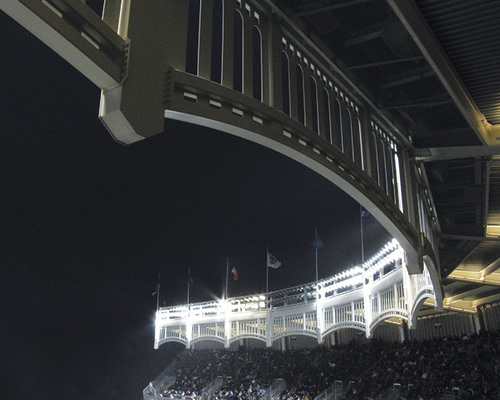Yesterday, my wife Marcie and I continued our Southeast Asia “inspircation”—a vacation that involves research and inspiration-finding for our 2018 projects—by exploring the Angkor region near Siem Reap in Cambodia.
Our day began early. REALLY early. We set our alarms for 4:20 am and trudged wearily down the stairs to collect a pre-packed breakfast from our hotel, then clambered into our tuk-tuk, which we had arranged to tour us around for the day. Our driver was the same one who had taken us from the airport the previous evening—the ever-smiling Yam. He whisked us away into the dark and we found ourselves feeling a bit bewildered. We had been in Cambodia for less than a day and, here we were, wheeling towards adventure in the wee hours of morning.
Even at this time of day, the town was beginning to animate. People were setting up their stalls and the roads were already filled with traffic.

Yam took us to the visitor centre for Angkor, where we purchased our tickets. You can choose between one-day, three-day, and seven-day passes. Even though we intend to only spend two days exploring temples, we chose the three-day pass, just in case. Despite the early hour (by this time it was just after 5:00 am), the entire centre was swarming with tourists. Thankfully, the longest lines were for one-day passes. We hurriedly bought our tickets, then jumped back into our tuk-tuk and headed off to our first temple: Angkor Wat, the largest religious monument in the world.
Originally constructed as a Hindu temple worshipping Vishu during the Khmer Empire, the site was gradually converted into a Buddhist temple near the end of the twelfth century. It’s now a UNESCO world heritage site.
Here is a map of the entire Angkor region. We ended up doing ten temples in the single day:
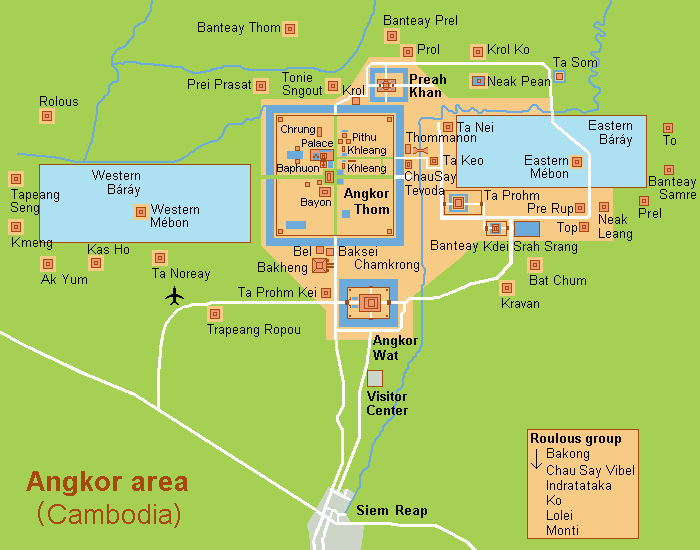
When Yam dropped us off at the entrance to Angkor Wat, we were so drowsy and out of sorts that we didn’t even really pay attention to where we were and simply wandered off into the darkness (which caused us a problem later in the morning, but more on that later). It was still pitch dark and we just did the lemming thing and followed after the dozens of people trekking towards the temple complex. It felt surreal, like we were wandering through a dream.
The reason why everyone starts the day so early at Angkor Wat is to experience the sun rising over the distinctive domes of the temple. Somehow in the lack of light, we found our way onto a stone ledge of an ancient structure and there we sat, waiting for the dawn, and munching on the miniature bananas that were in our pre-packed breakfast.
Eventually, magically, the temples began to resolve before us . . .
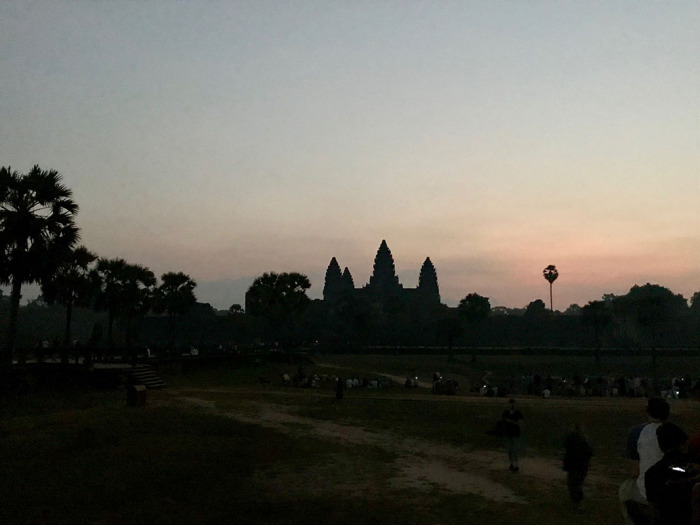
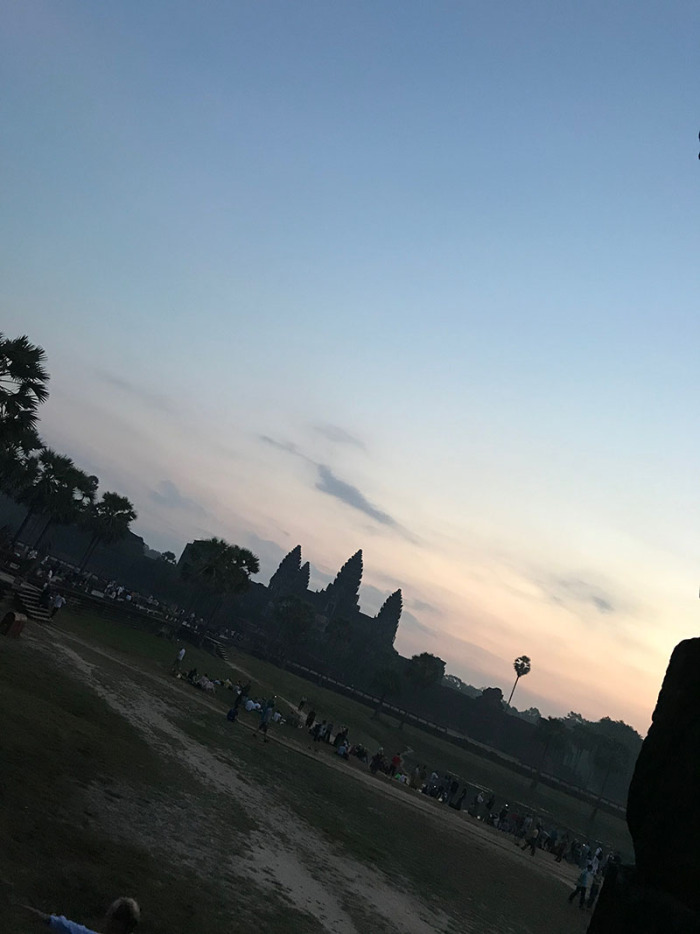
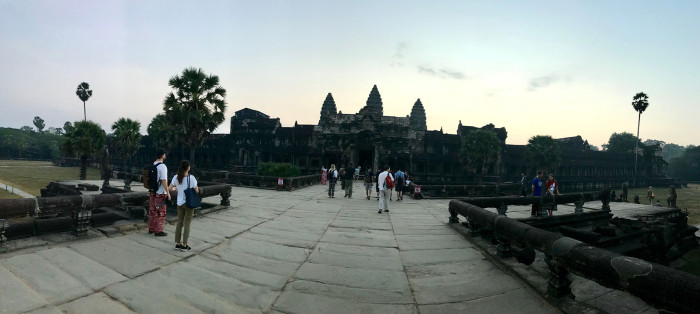
Once it was light enough, we scurried off our ledge and headed into the temples to do some exploring. It was only then that we were aware just how many people were around us. They were perched on the stones, standing on the lawns and bridges—they were everywhere, all watching the sunrise.
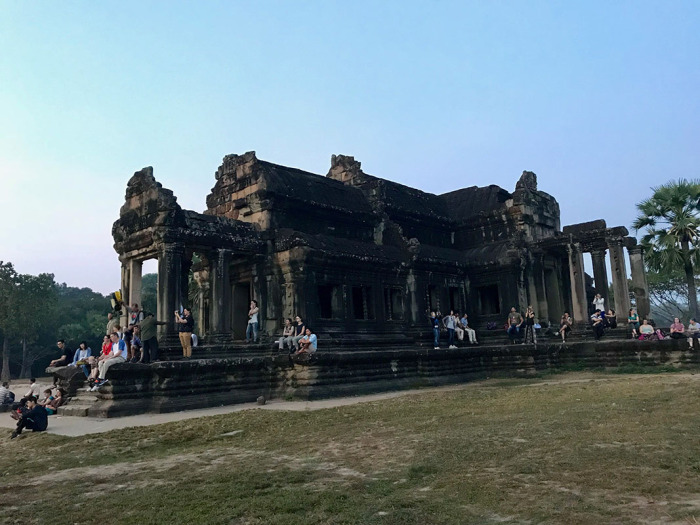
As we made our way through the structures, the sun continued to climb, offering us many different views of the light peeking over the temples.
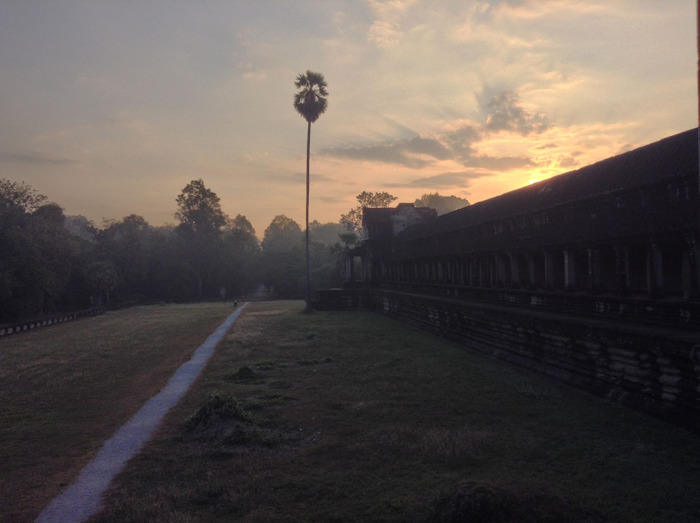
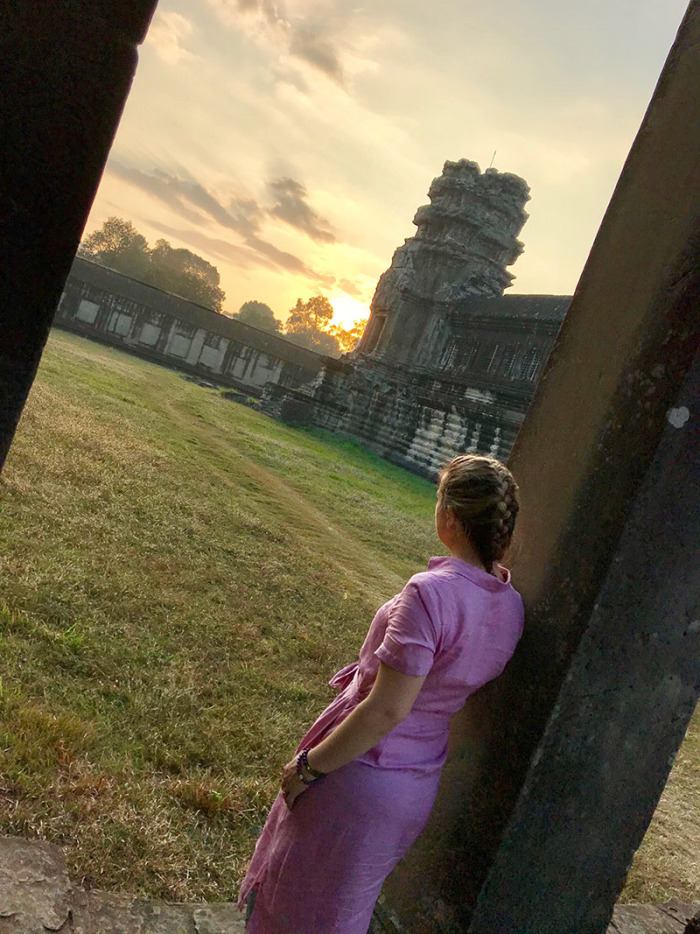
No wonder everyone wants to visit the temple for this event; it’s mesmerizing!
We took countless photos of Angkor Wat and the truth is that none of them do our experience any justice. The scale, the detail, the wonder of it all is truly overwhelming.
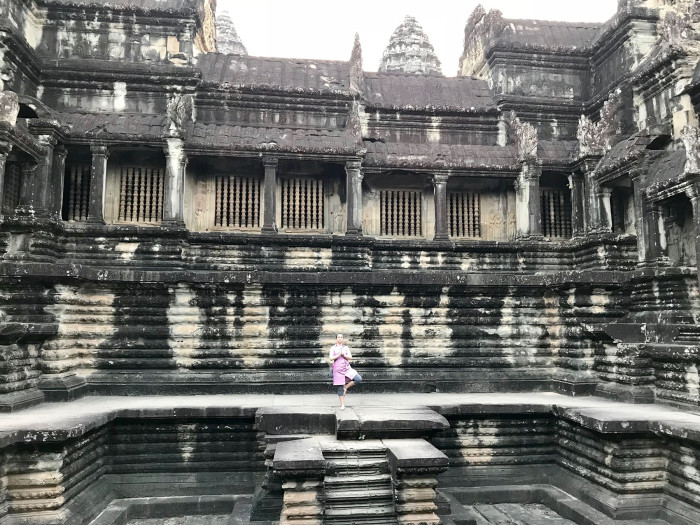
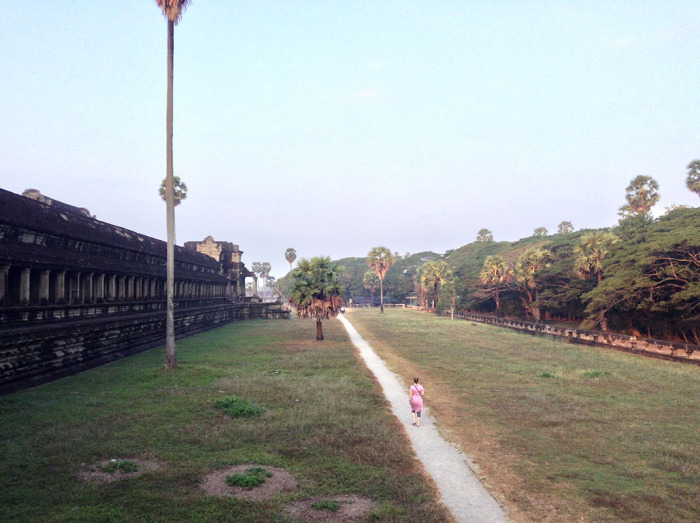
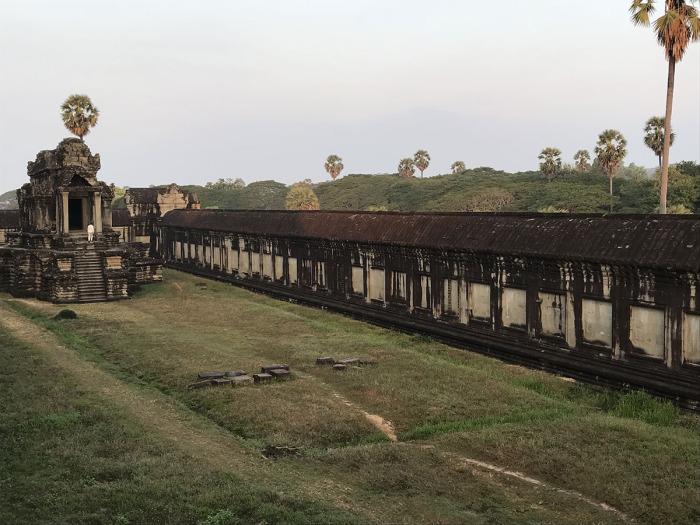
By the way, that’s me at the top of the stairs in the above photo!
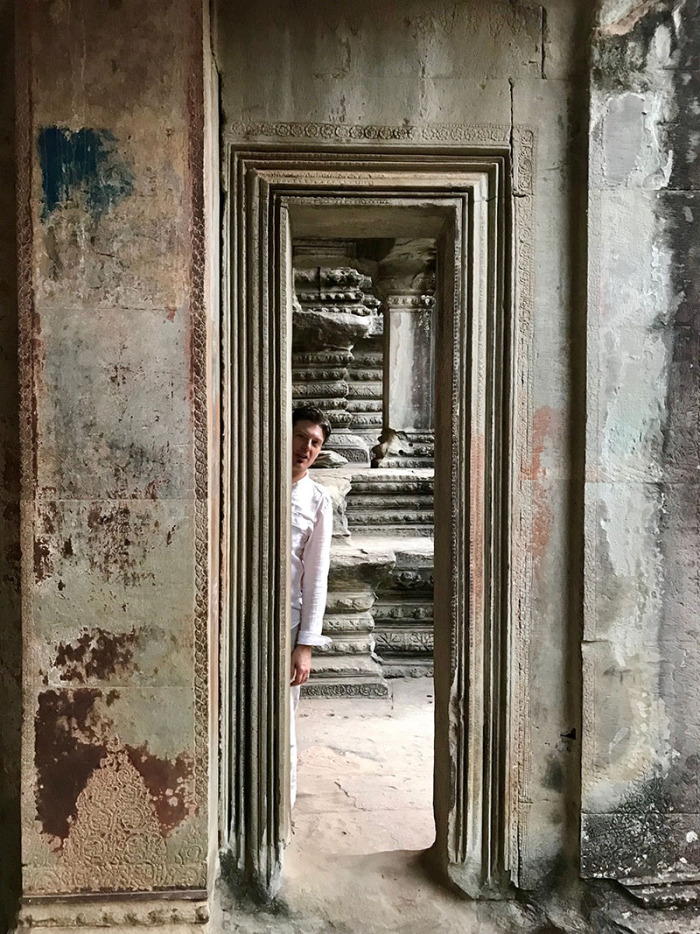
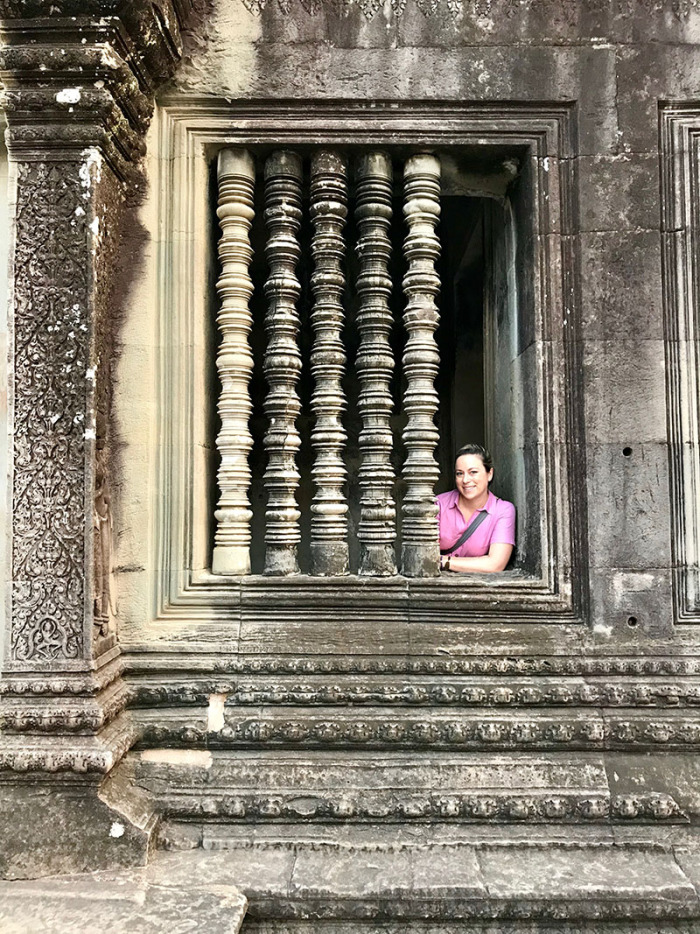
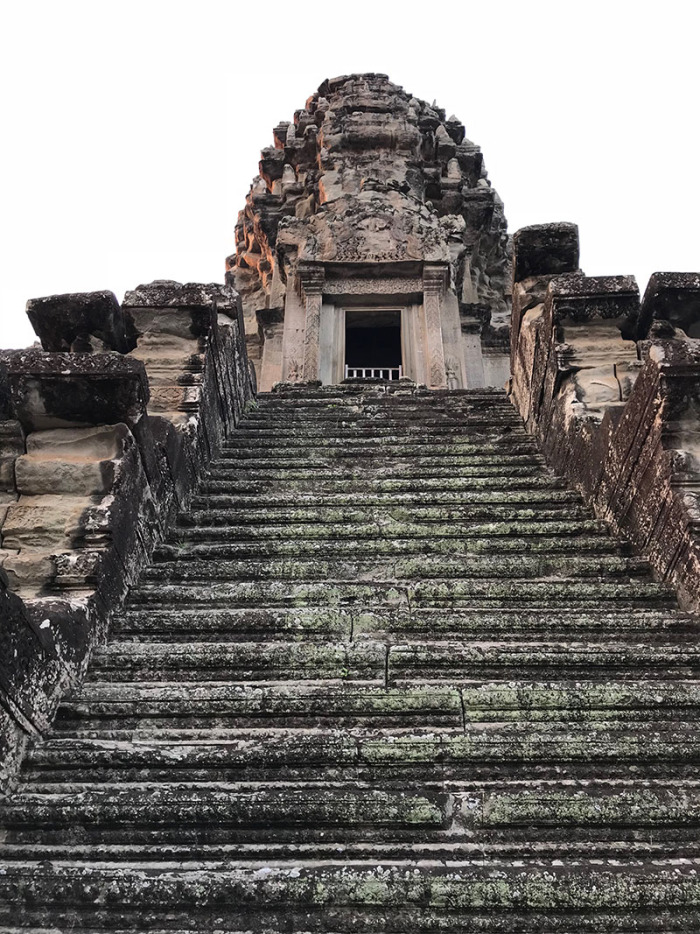
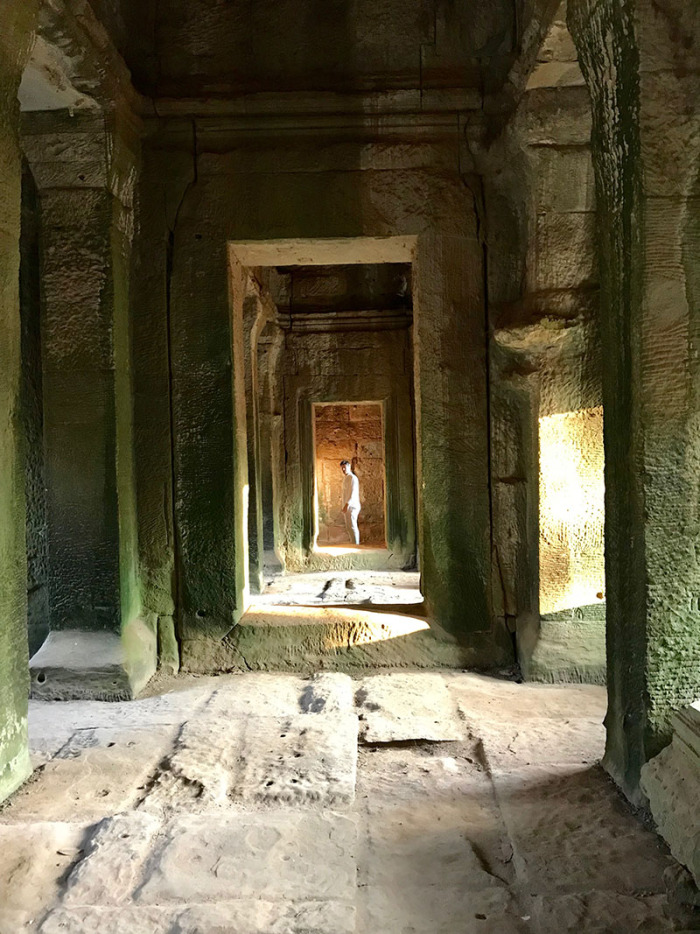
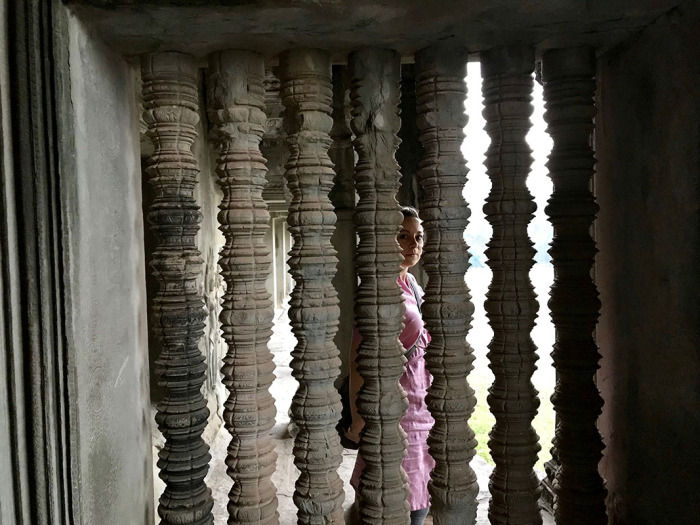
There are so many intricate details to discover:
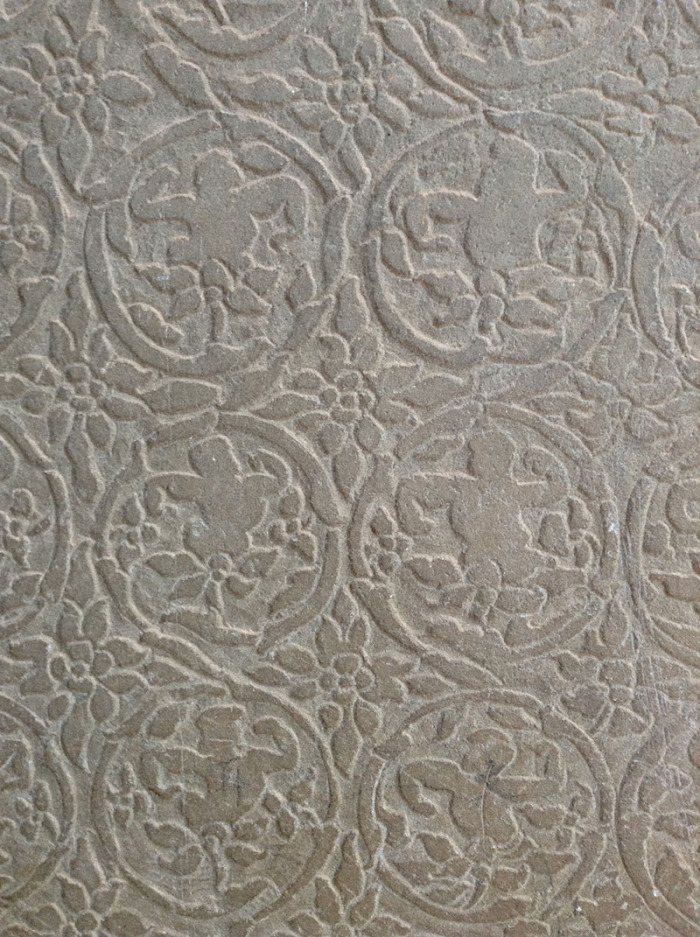
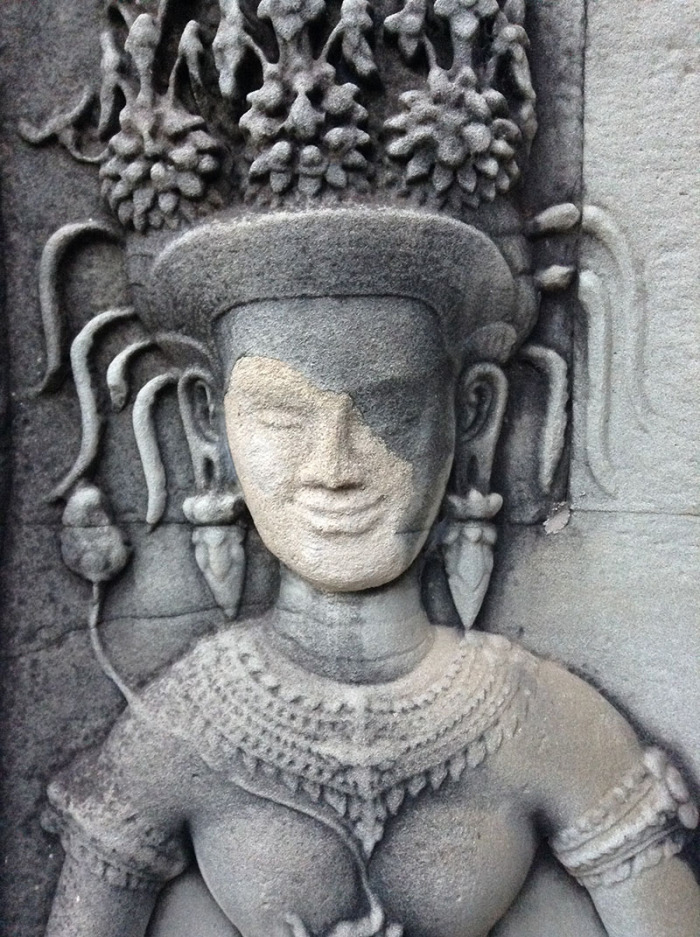
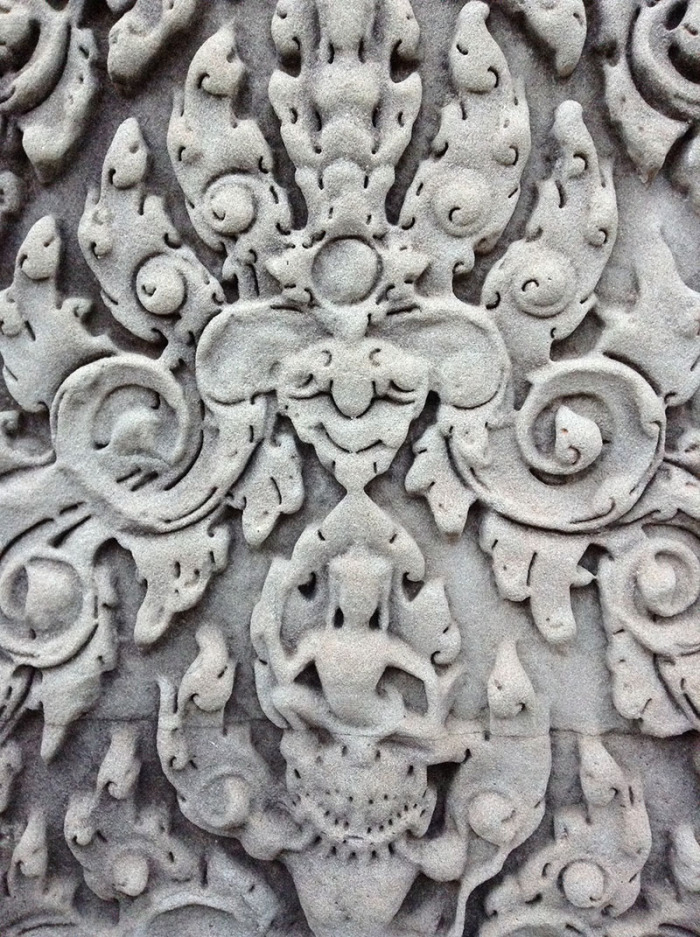
Much of the grounds are strewn with rubble; this is a temple (as with all the temples in Angkor) that is a constant state of upkeep, repair, and restoration.
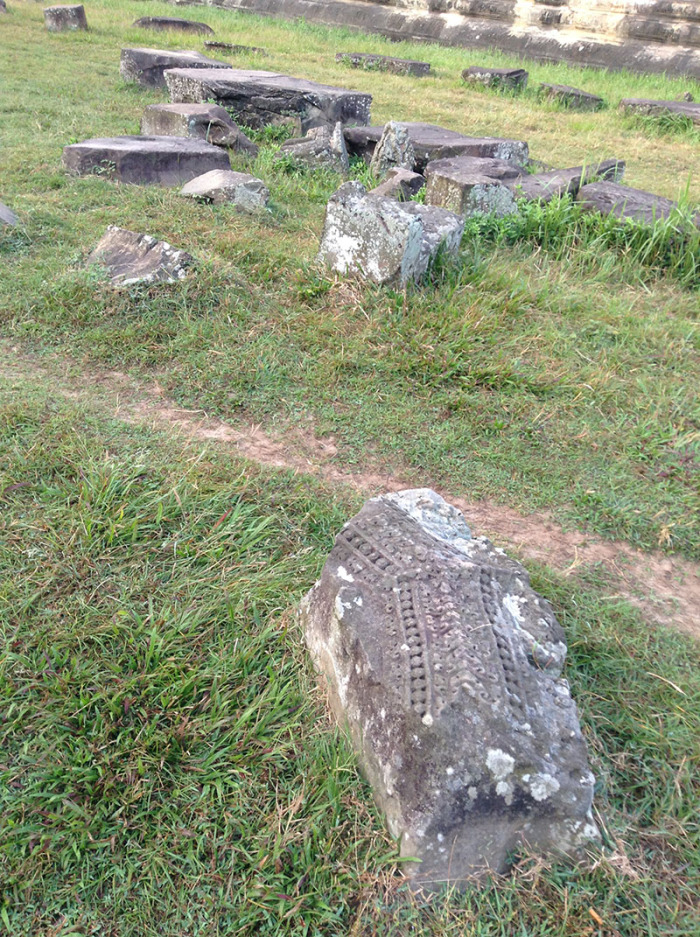
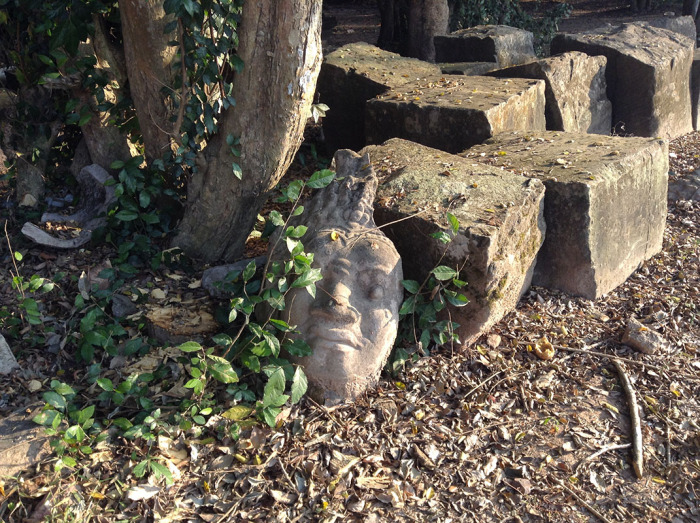
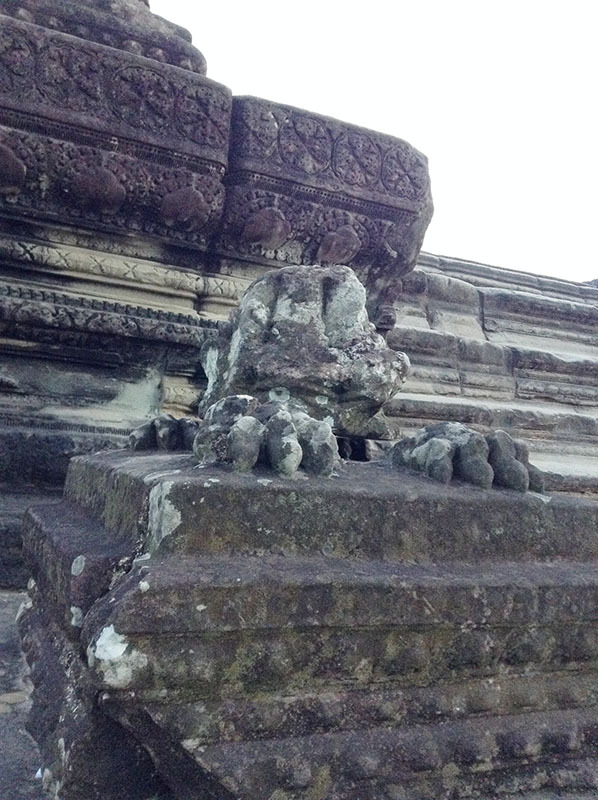
The temple is still surrounded by everyday life. In the temple itself, you can receive a blessing from a Buddhist monk:
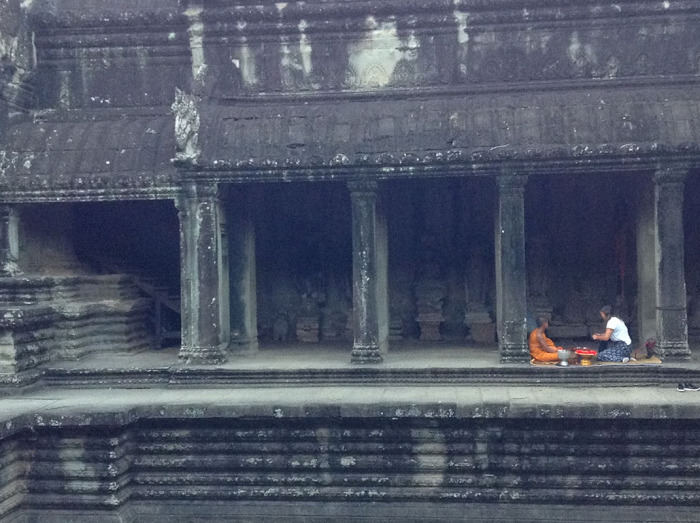
And, in the jungle surrounding the temple, there are locals roaring around on scooters and bicycles, going about their usual activities.
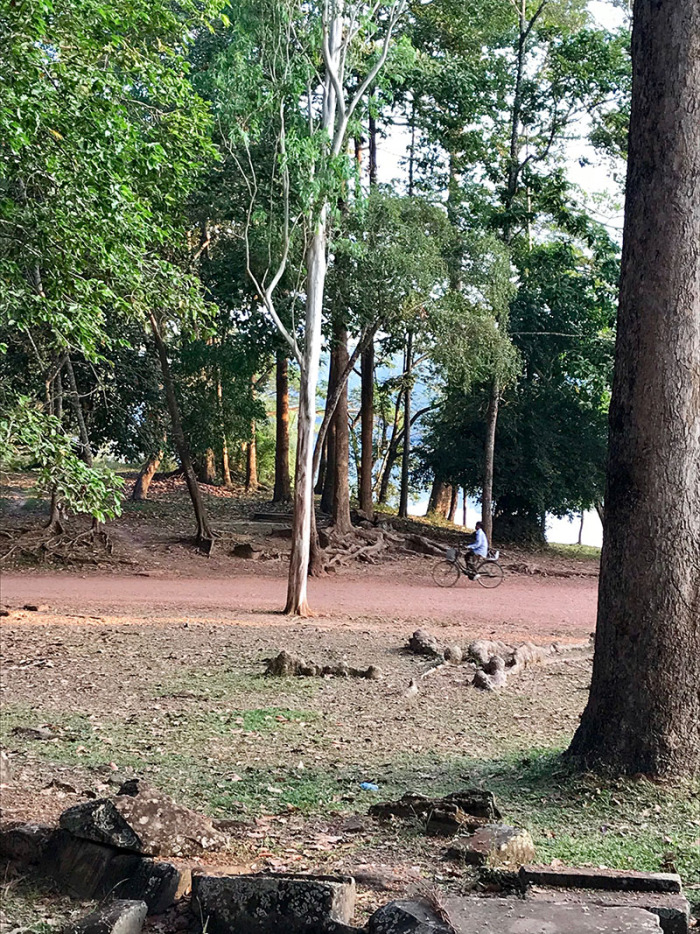
There is another type of local at Angkor Wat: the monkeys. We saw our first sighting along a jungle path, but as we reemerged to the front side of the temple, we saw that they had appeared in bunches to beg treats from the tourists. They were pretty cute, especially the babies!
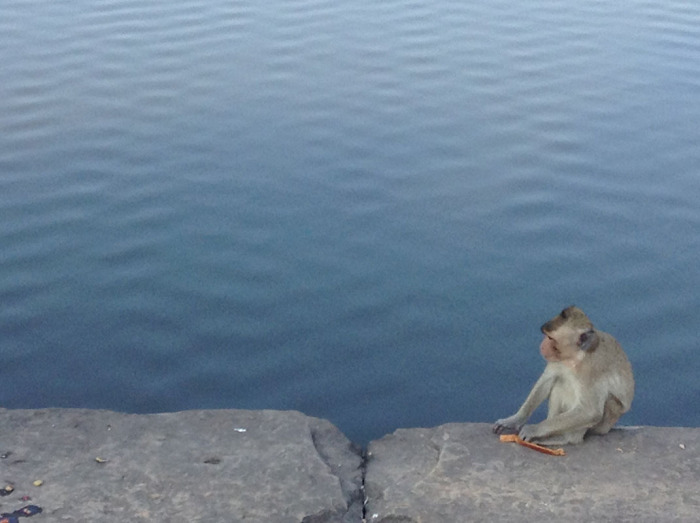
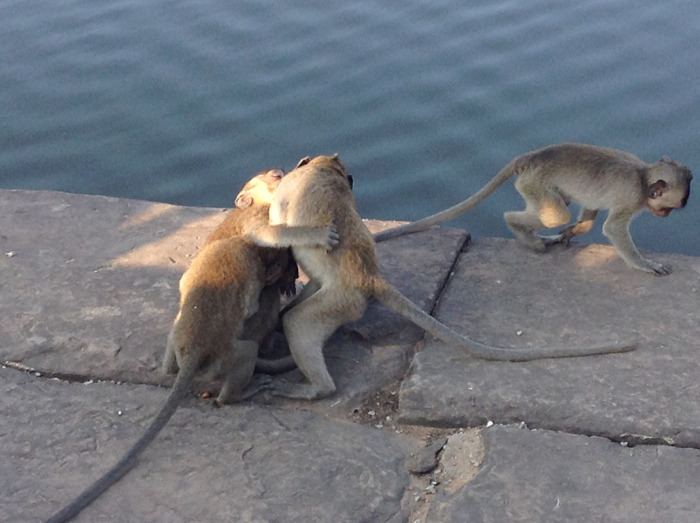
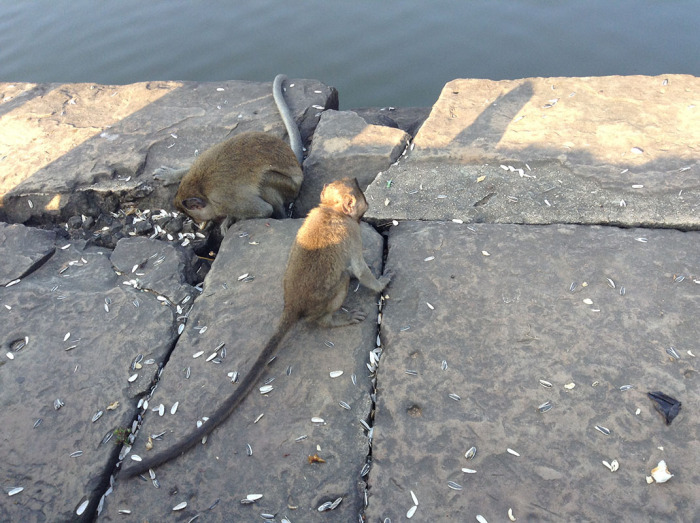
By the time we were done exploring Angkor Wat, it was sometime after 8am, which meant we had already spent several hours at the site. We set off to find Yam, first collecting some water along the way. The temperature was already above 30 degrees Celsius!
It was at this point that we encountered a problem: we couldn’t find Yam. Now that it was daylight, everything looked completely different (read: visible). We wandered up and down a busy line of vendors, past the tourists and countless tuk-tuks, seeking our driver. There was a bit of an argument about where to look next, but eventually we settled on retracing our path and this time we found Yam waving at us from a row of parked tuk-tuks. A quick greeting and we were happily on our way again.
Angkor Thom: Prasat BayonAngkor Thom is the most recent temple of the Khmer Empire, and includes many sites. The entrance gate and the first temple you encounter, Prasat Bayon, are absolutely amazing.
There we were on our tuk-tuk when, almost suddenly, magically, there appeared an enormous gate with giant faces at its peak. It felt like we were approaching the set of some movie—Indiana Jones or Jurassic World, perhaps. Then we realized the entire avenue—a broad bridge, was lined with large stone busts.
This bridge was teeming with people of the real variety, but Yam allowed us to quickly hop out of the tuk-tuk to snap some photos. Others we were able to take after we climbed back aboard our ride and were being driven through the gate itself.
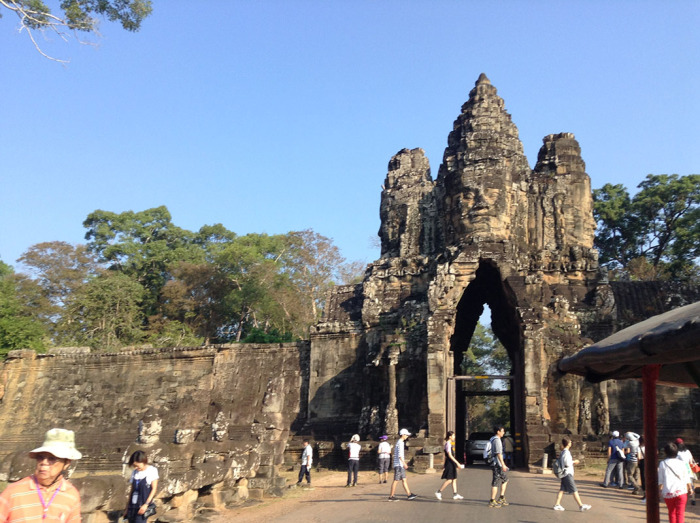
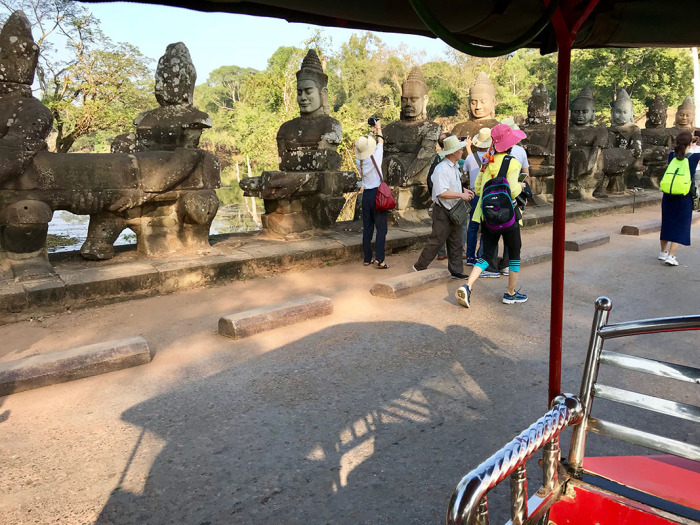
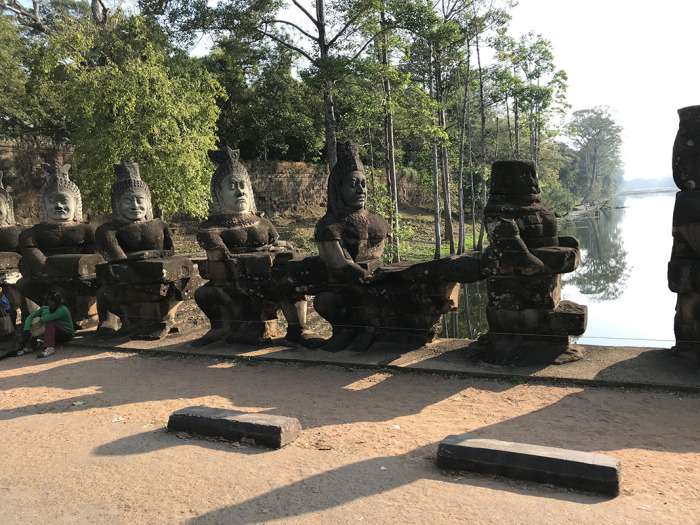
A short ride past the gate and we reached Bayon—which Marcie and I immediately dubbed “face temple.” It’s what makes this temple so distinctive. Serene and smiling faces seem to greet you from every angle; each time I turned around, there was another one to contemplate. Every view, every perspective, was a picture of stone and interesting negative space.
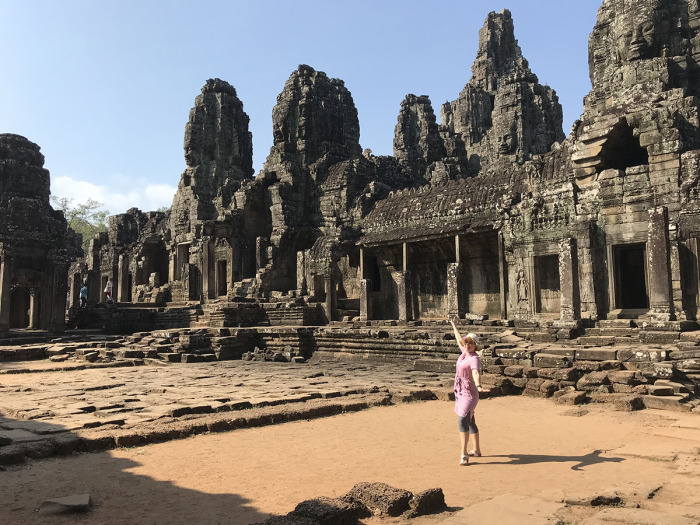
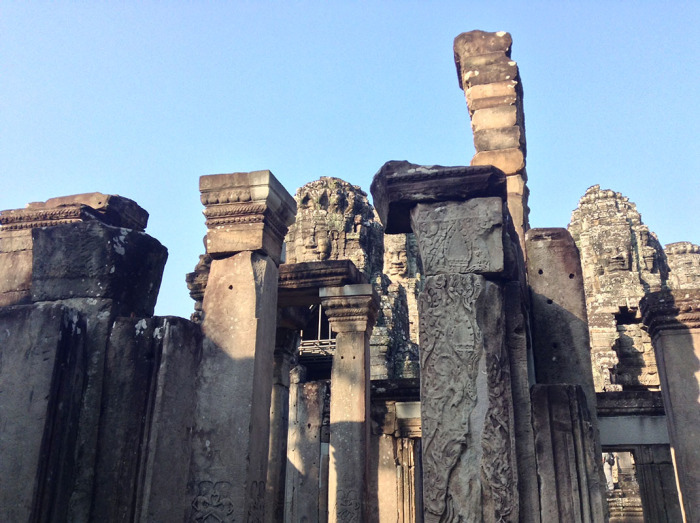
Each of those domes you see in the photo below are hollow. Inside and looking straight up, I could see (and hear) bats fluttering. That only added to the exotic feeling of the place.
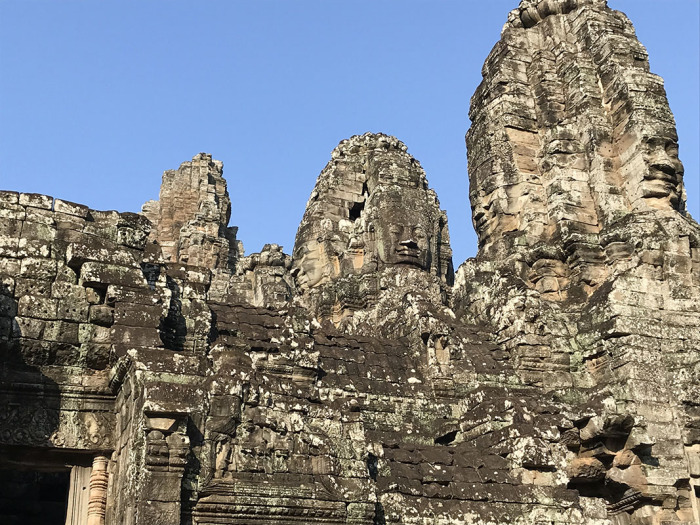
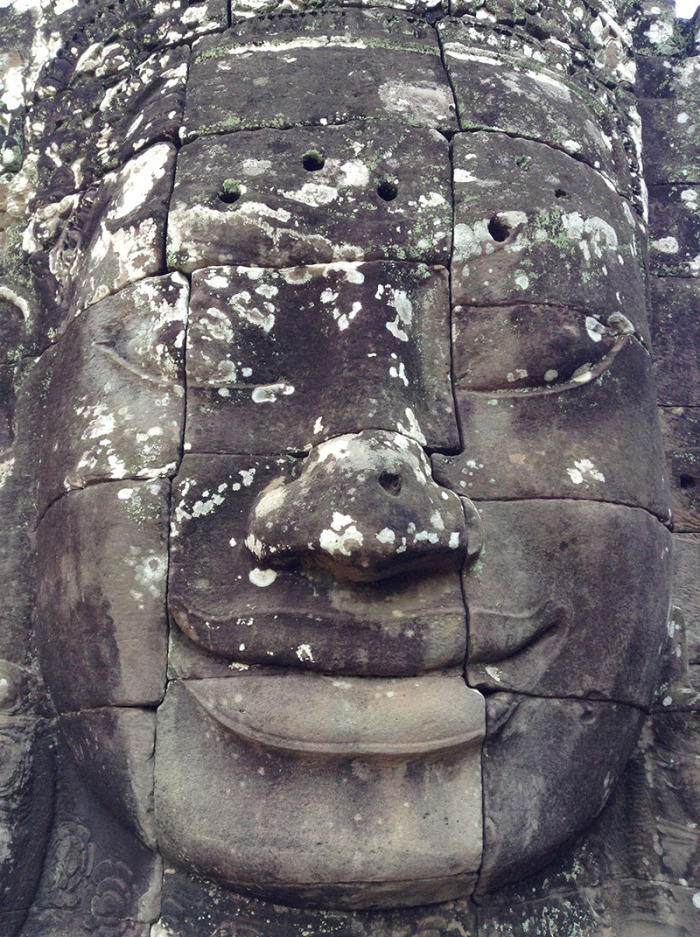
This was one of the busier temples we explored, mostly because the site features many cramped squares and avenues and all the tourists are competing to capture different photos. Also, we noticed an entire tour bus had arrived from the opposite side of the temple just after us—so it was kind of a perfect storm. Despite this, we were still able to find our own little corners to explore and to take photos.
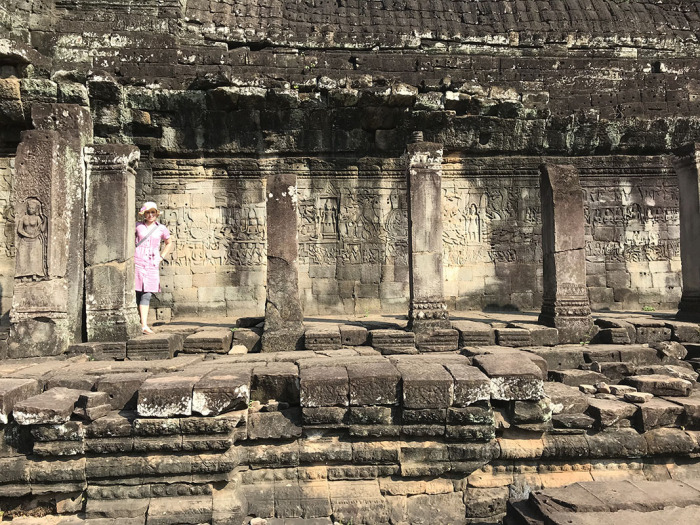
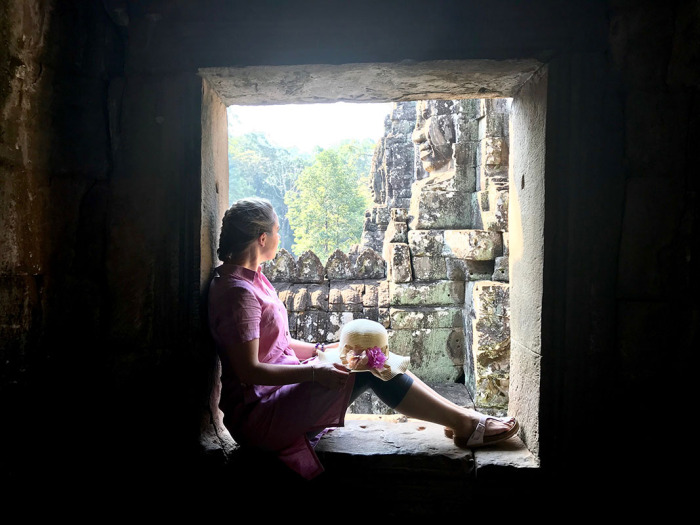
Near the back of the temple, we were able to find some additional space. I took this opportunity to dig out my sketchbook and do some note-taking and brainstorming. The inspiration was coming fast and furious! This temple in particular was really helpful for the worlds I have to build for my new fantasy series, Zoone. Book 1 is already done and ready for release in 2019, but there are two more for me to write, and both contain a vast array of rich worlds that need to be distinctive and unique, while at the same time feeling like they belong to a real place. Visiting a realm like Angkor is the perfect fit for me during this part of the writing process.
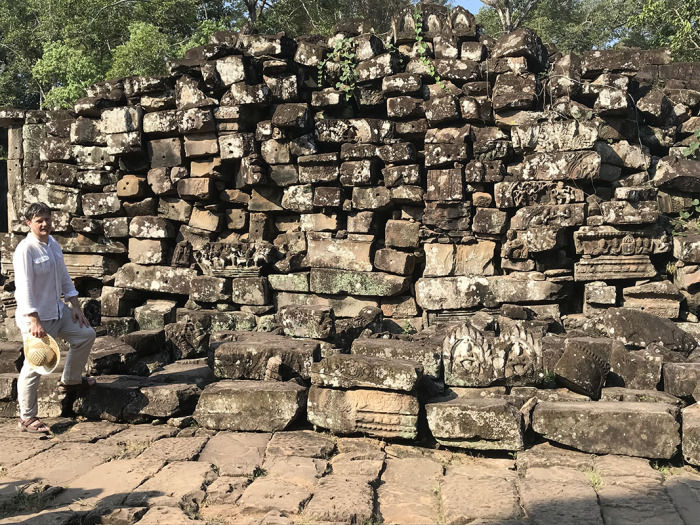
In one section of the temple, we found a group of people in traditional costume. For the price of an American buck, we could take a photo with them. The line was long (if you could call it a line; it was more of a swarm), but we wriggled Marcie to the front and she eventually got her turn:
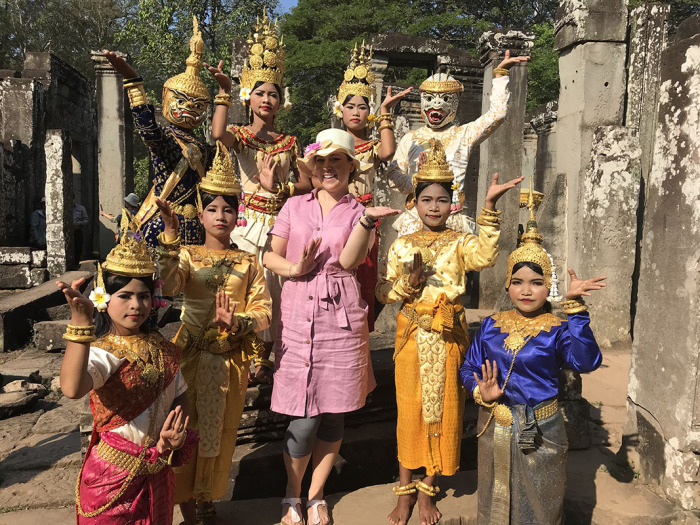
From Bayon, we made our way on foot to the next site, Baphuon. This temple was a lot less busy and had less-constricted grounds. By the time, we were starting to wear out, but we still managed to climb to the top. The stairs were wooden and built over the original stone steps, but they were so steep that they were very treacherous. I noticed many people climbing down backwards.
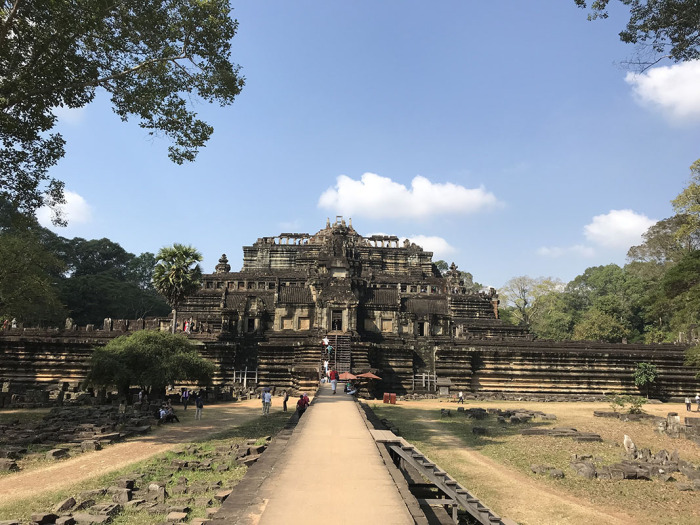
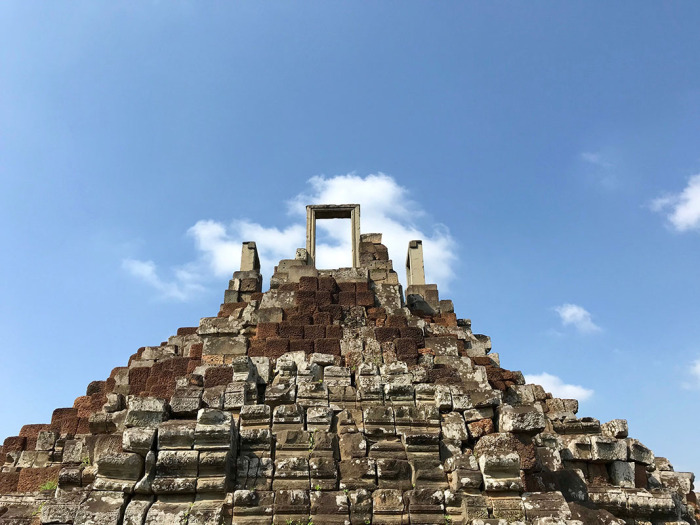
The climb was worth it; the view was amazing and we got a closer glimpse at some of the stones and details up there.
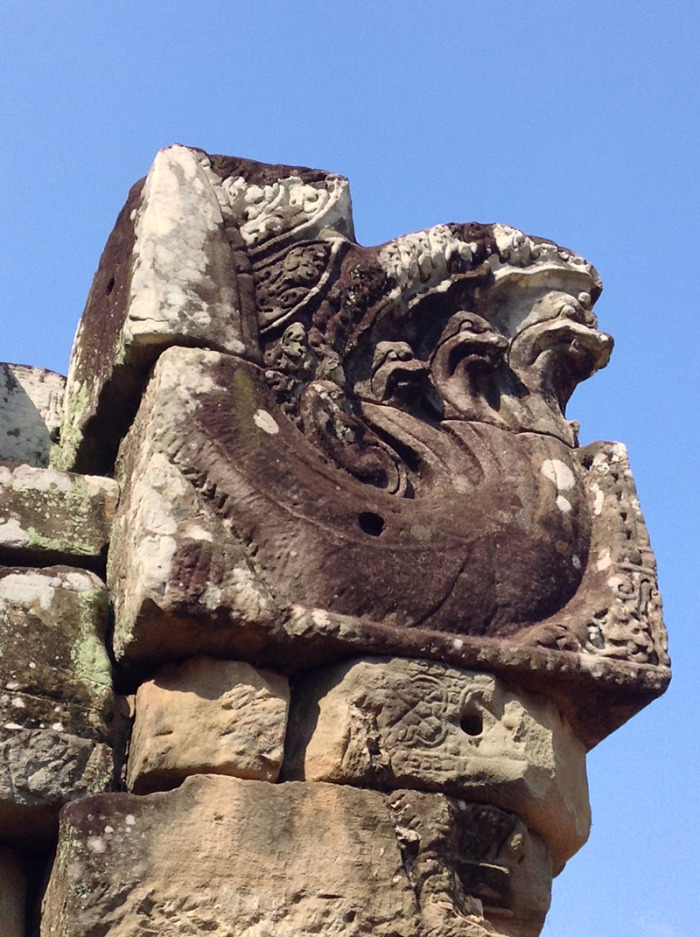
After climbing down, we followed the marked paths through the jungle, wandering past the remnants of stone walls and doorways, slowly being reclaimed by the trees. Once again, it felt like we wandering in the footsteps of some action-adventure hero like Tin Tin, Lara Croft, or Indiana Jones.
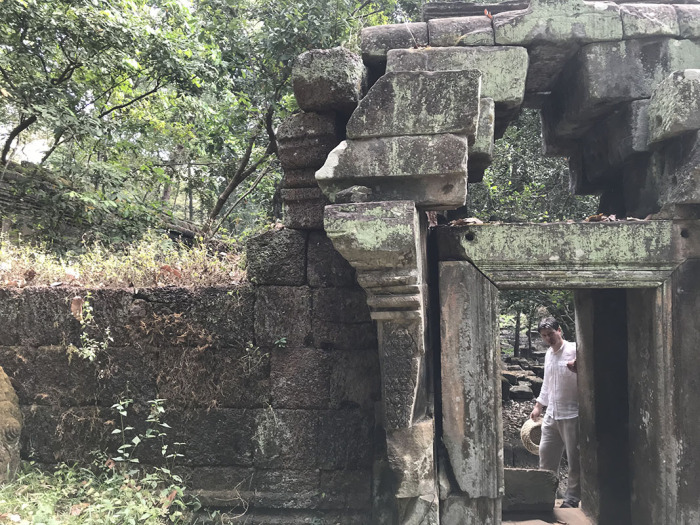
We soon reached Phimeanakas, a Hindu temple protected by statues of cat-like creatures (lions?) and, in days gone by, a moat.
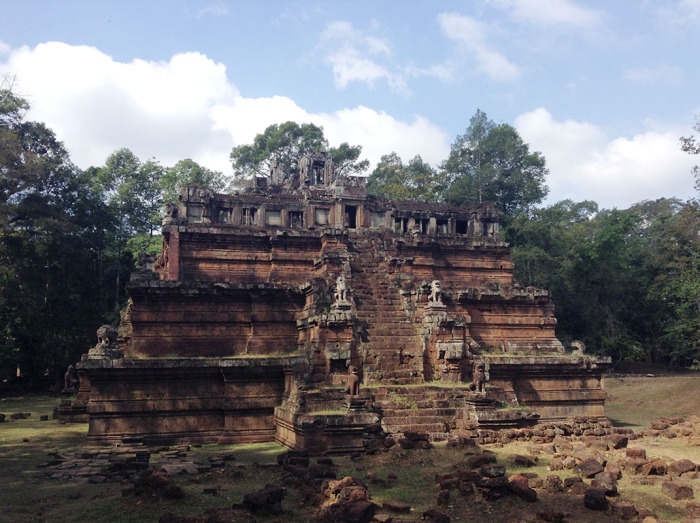
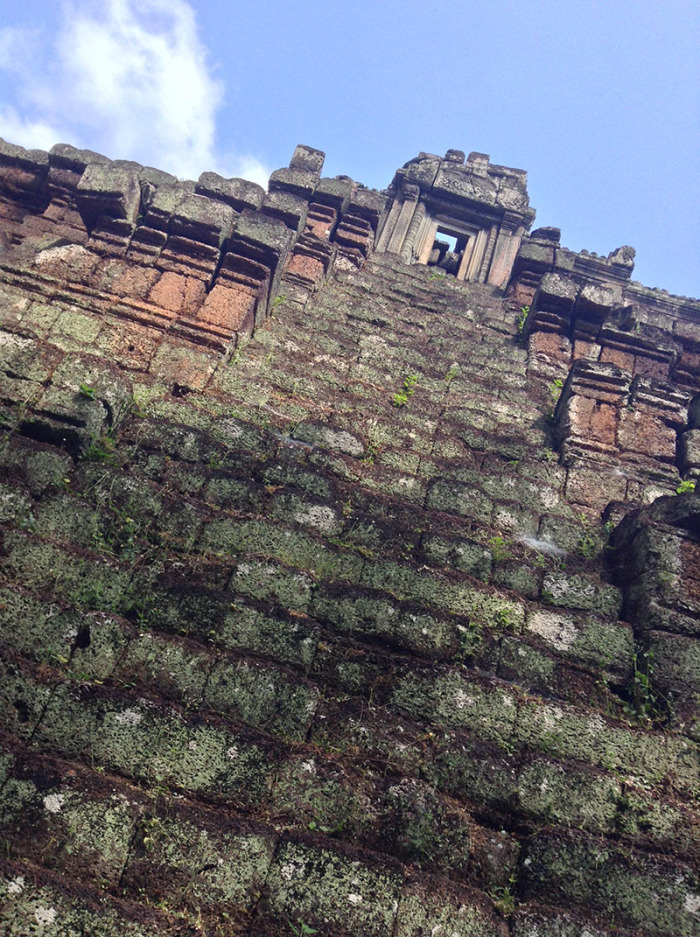
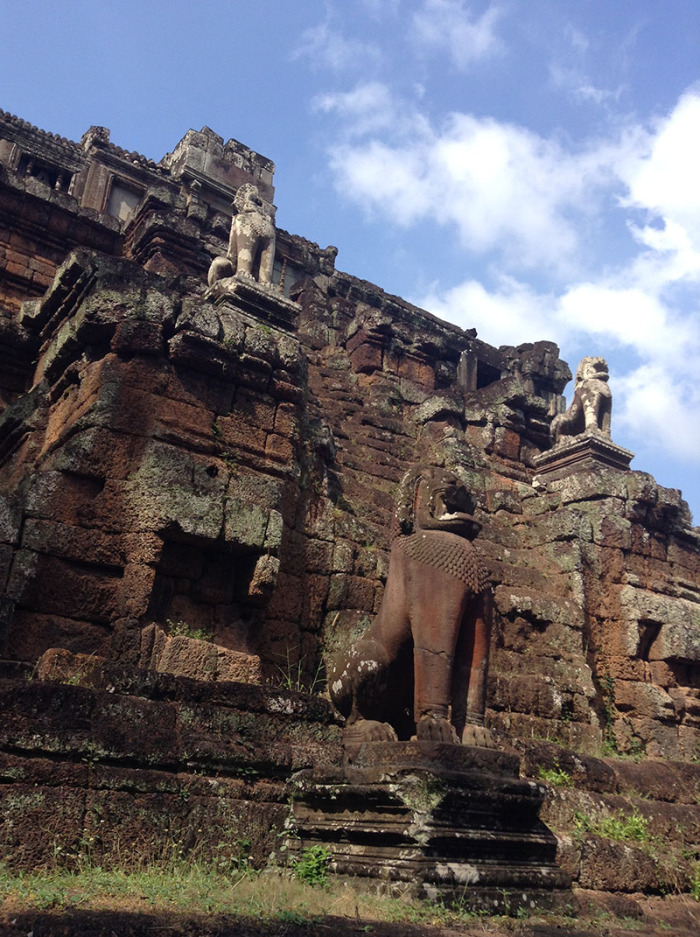
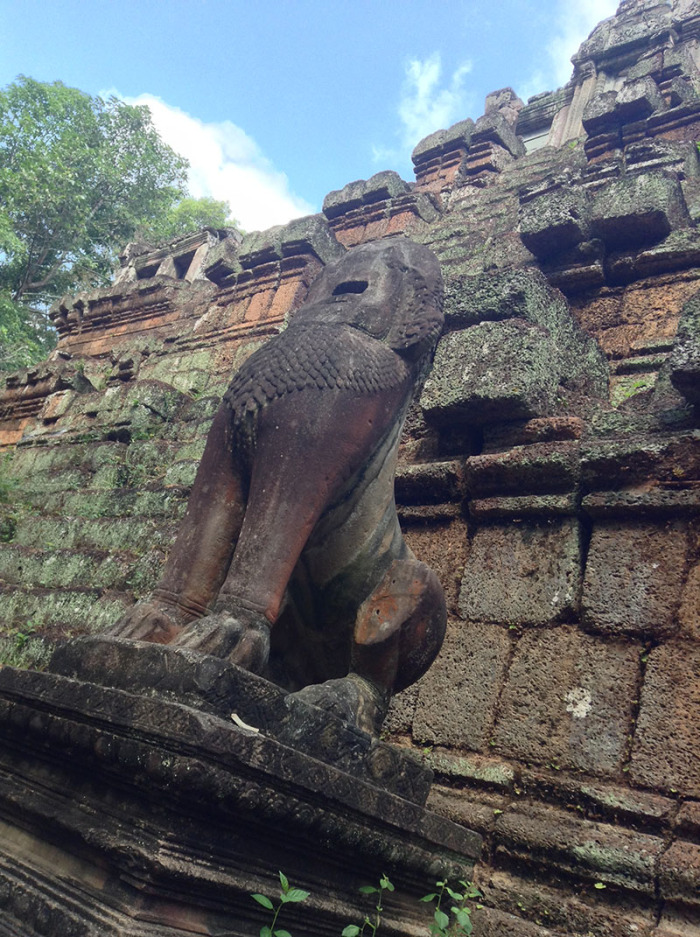
This temple reminded me of one of my favourite childhood books and movies, The Jungle Book. There’s a scene in the 1967 animated film in which Bagheera, in an attempt to hide from the monkeys, pretends he’s a stone statue:
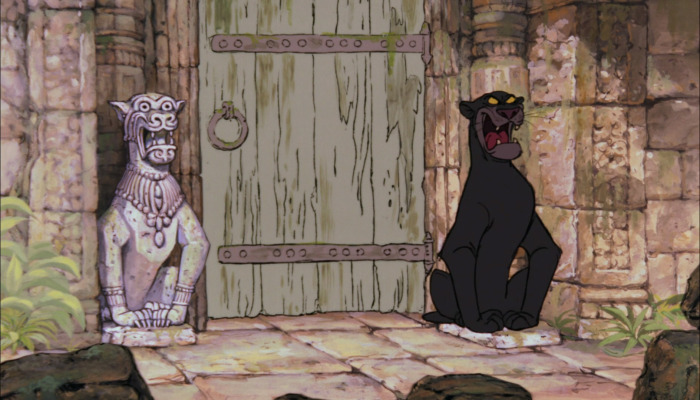
Another short walk, and we arrived at the aptly-named Terrace of Elephants. It was originally attached to Phimeanakas, but time and wear leave it as a stand-alone monument. It was once a terrace from which the Angkor’s king could watch his returning army.
The elephants of stone are quite delightful—look down the line of the photo, and you will notice their protruding tusks.
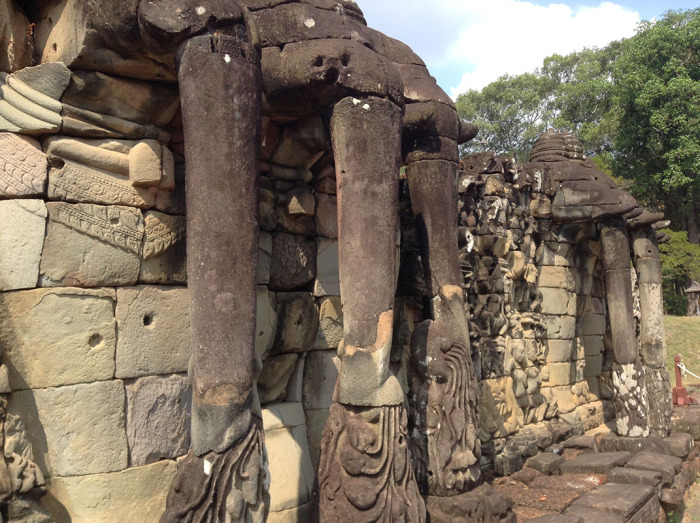
Another elephant, down below at the side of the terrace, emerges out of the brickwork.
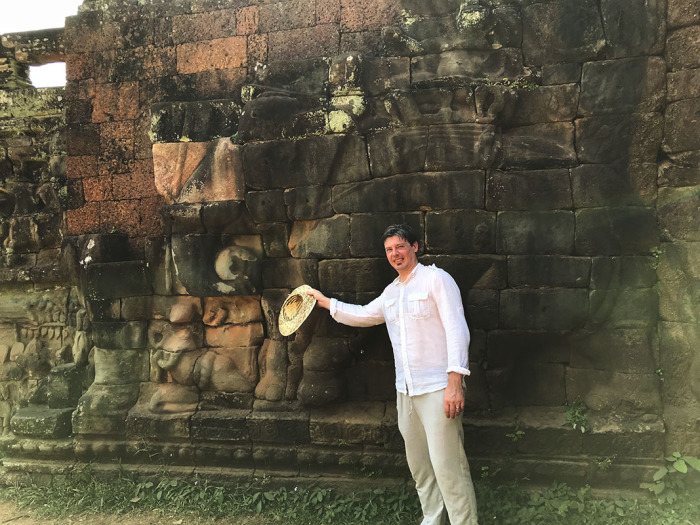
There was more to see at this site, but we decided to find Yam and carry on. Back on our tuk-tuk, and we headed to a pair of temples that now flank a modern road: Thommanon and Chau Say Tevoda.
If we had not already visited Ankor Wat and Angkor Thom, we might have found ourselves amazed by these sites, but we were feeling a little beaten down by over-stimulation—not to mention the heat. We took fewer photos here and contented ourselves with wandering around the structures.
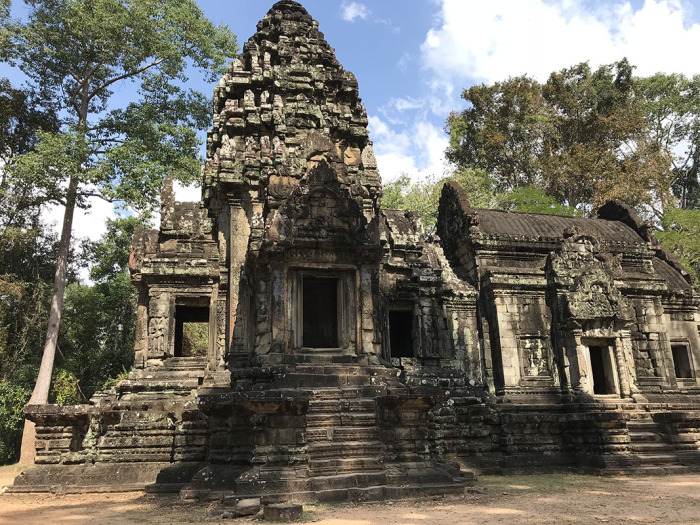
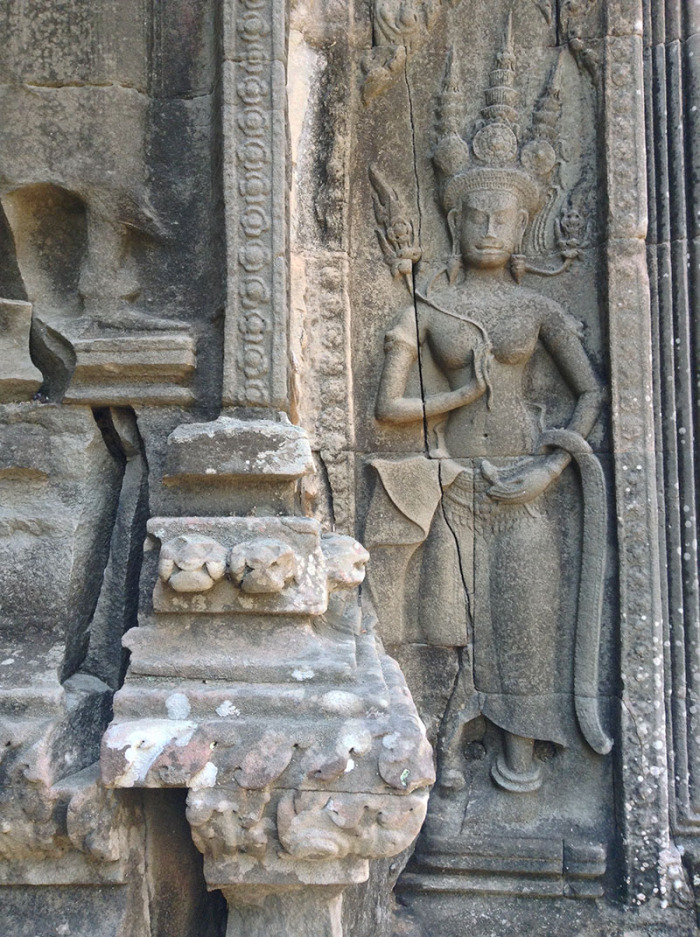
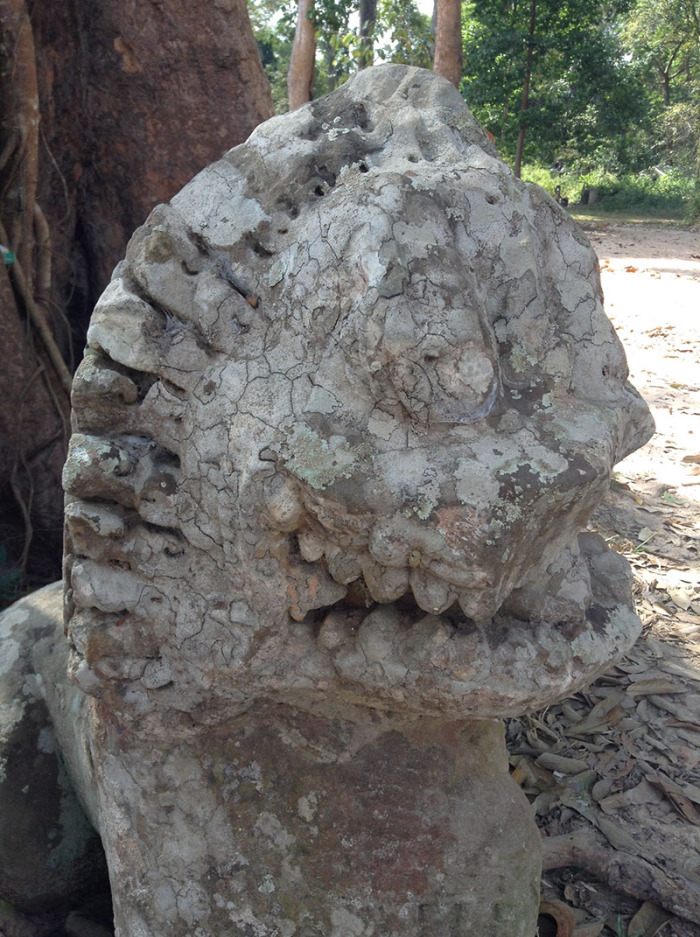
There was a long strip of booths here, with locals entreating us to buy their wares. We were only interested in water!
Ta Keo TempleAt this point, we were feeling “templed out,” but Yam knows this plan like the spokes of his scooter, so he advised us that we should visit one more site before breaking for lunch. By this point, we had already been up for eight hours, hiking up and down staircases in the heat.
Still, we soldiered on and visited Ta Keo, a sandstone temple in a severe state of renovation.
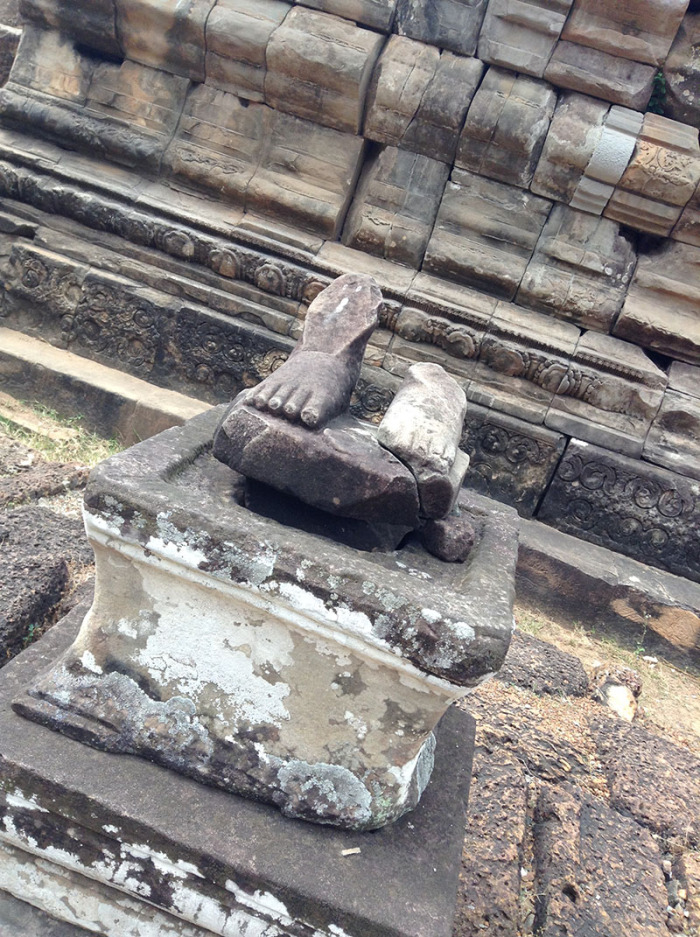 We wandered past the scaffolding, at which point Marcie declared she was going to sit out this climb. The steps were the original stone ones—and they were precariously steep. So, while Marcie rested at the bottom, I heaved myself to the top; witness my victory pose!
We wandered past the scaffolding, at which point Marcie declared she was going to sit out this climb. The steps were the original stone ones—and they were precariously steep. So, while Marcie rested at the bottom, I heaved myself to the top; witness my victory pose!
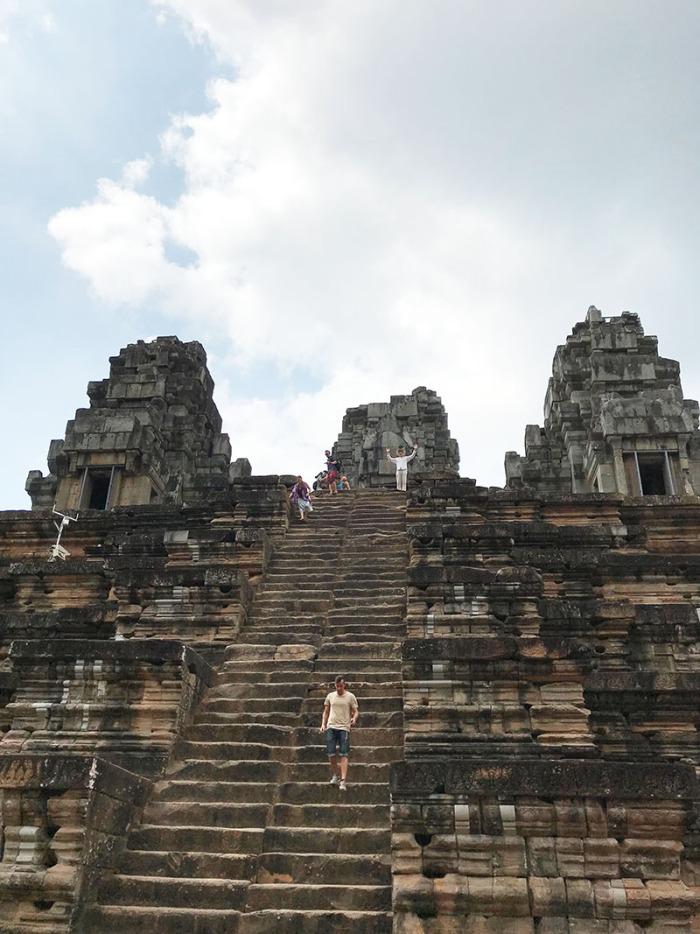
I wandered around the top of the temple, taking in the sights. I could see the street of “store fronts” below, the Cambodians getting on with their daily activities.
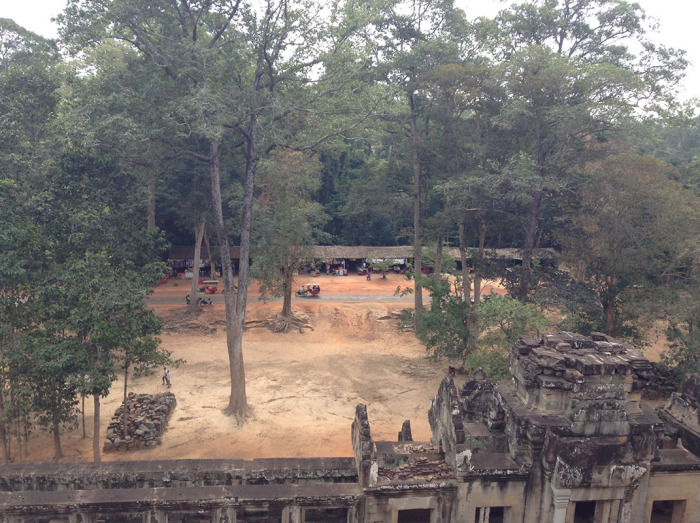
Once I climbed back down (carefully), Marcie had regained some energy. Not quite enough energy to climb all the way to the top, but at least halfway to pose:
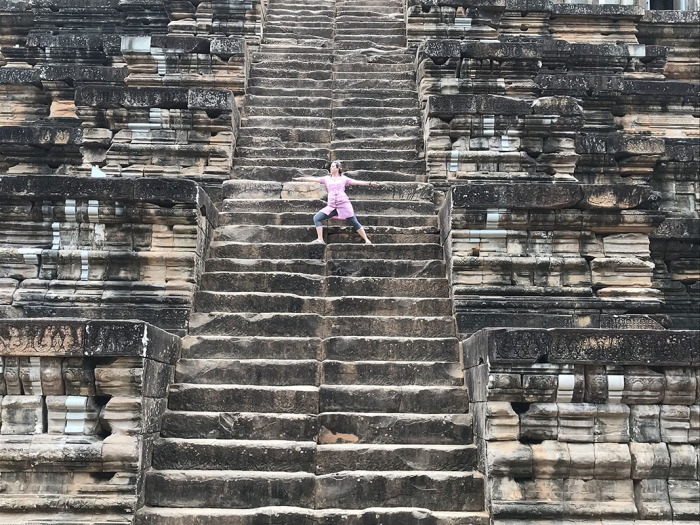
I felt I needed to use the toilet at this point, so began wandering through the jungle path, following the directions of the “WC” (water closet) sign. After several minutes, I still hadn’t found the toilet and felt like I had perspired all my moisture, so I simply turned around and headed back. Marcie saw me make the about-face and, wondering what I was doing, snapped this picture of a defeated soul:
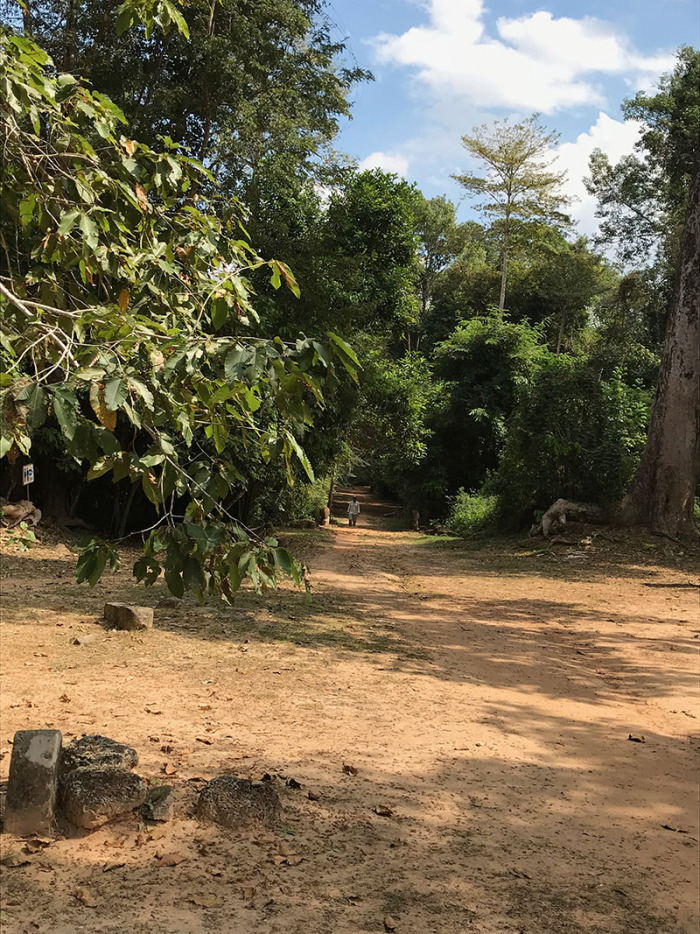
We crawled back onto our tuk-tuk, told Yam that we thought we could manage one more temple, but he smiled and said “time for a rest!” He drove us to a nearby restaurant where we sampled some Cambodian fare, drank some mango shakes, and tried to revitalize.
We were still feeling dehydrated, over-heated, and tired by the time we rejoined Yam after lunch, but eventually our food and drink kicked in. And then we reached the next temple, which completely rejuvenated us . . .
Ta ProhmThis is one of the most popular temples in Angkor because of the giant trees growing out of, on top of, seemingly as part of, the stones.
I’ll concur with the masses—this temple is absolutely enchanting. The tree roots reach down like fingers to clutch and squeeze at the stones of Ta Prohm and it’s like visiting a land out of a book. I was once again reminded of The Jungle Book, though Ta Prohm could also be a planet you’d find in Star Wars.
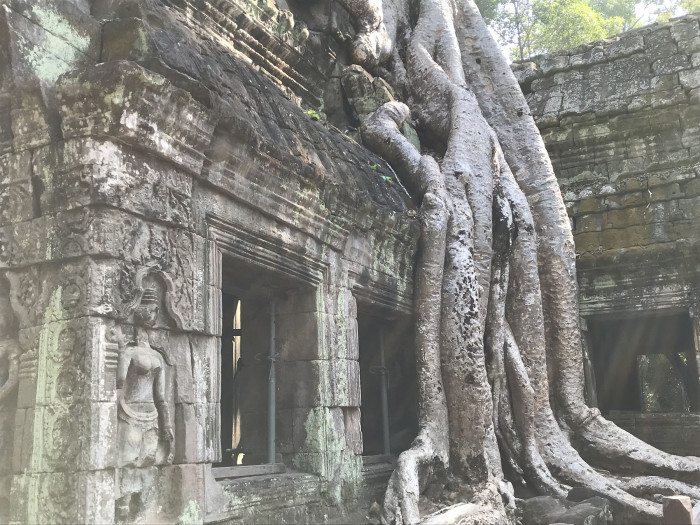
It was such a magical and mesmerizing place, perfect for finding world-building inspiration—and, like I mentioned above—visiting here completely restored our energy. My camera and notebook were out, and my imagination was firing on all cylinders.
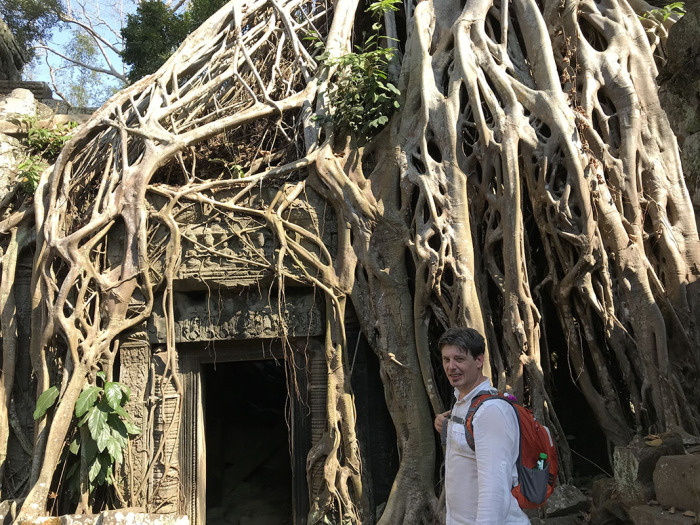
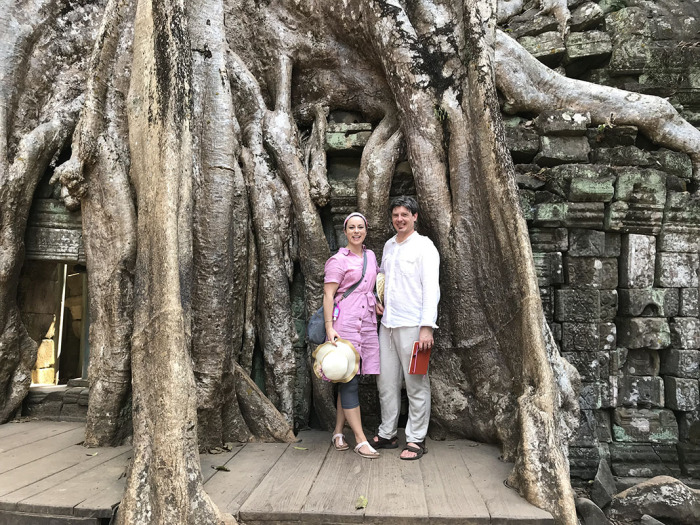
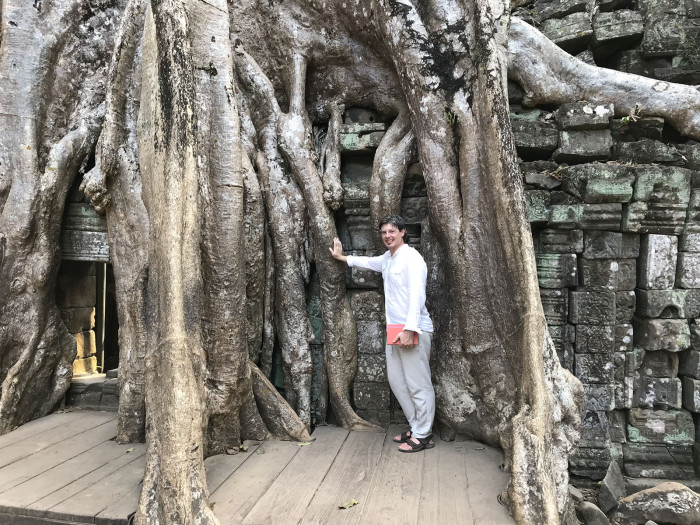
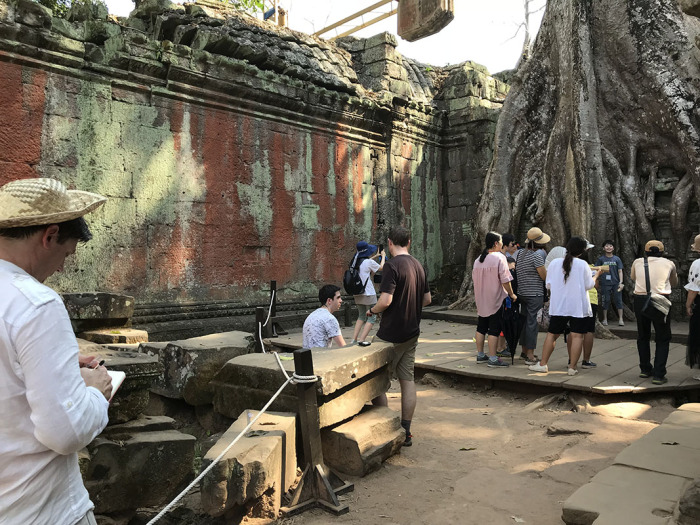
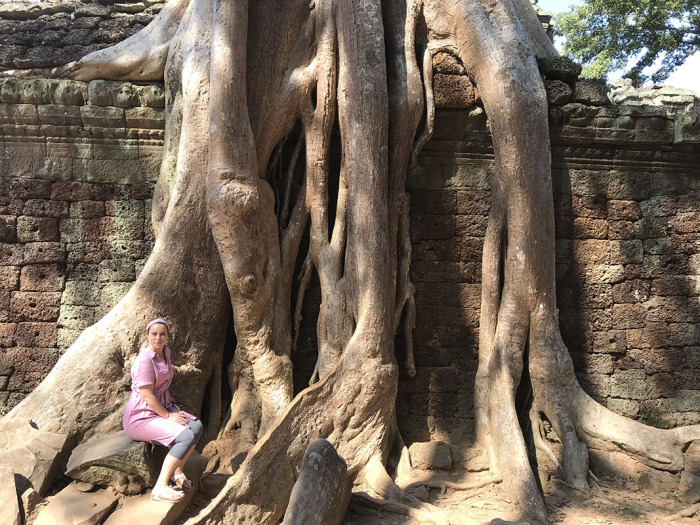
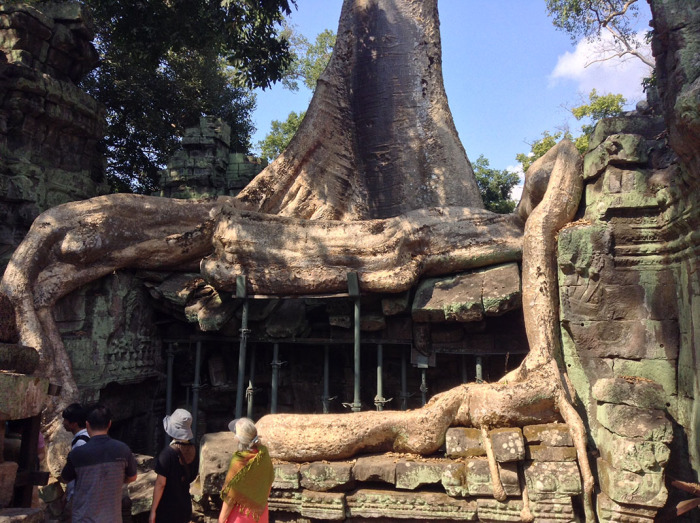
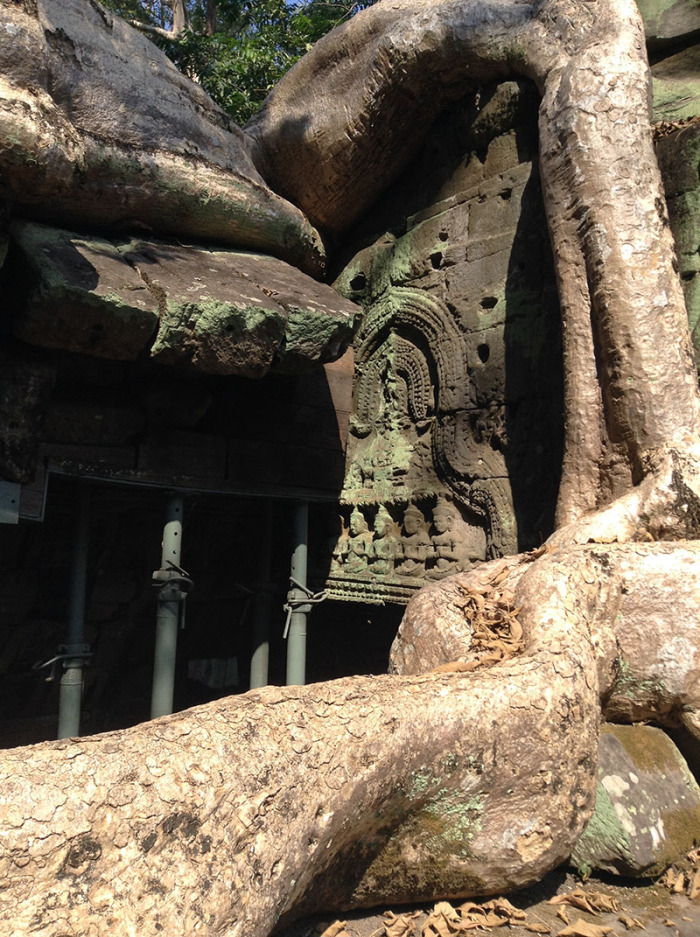
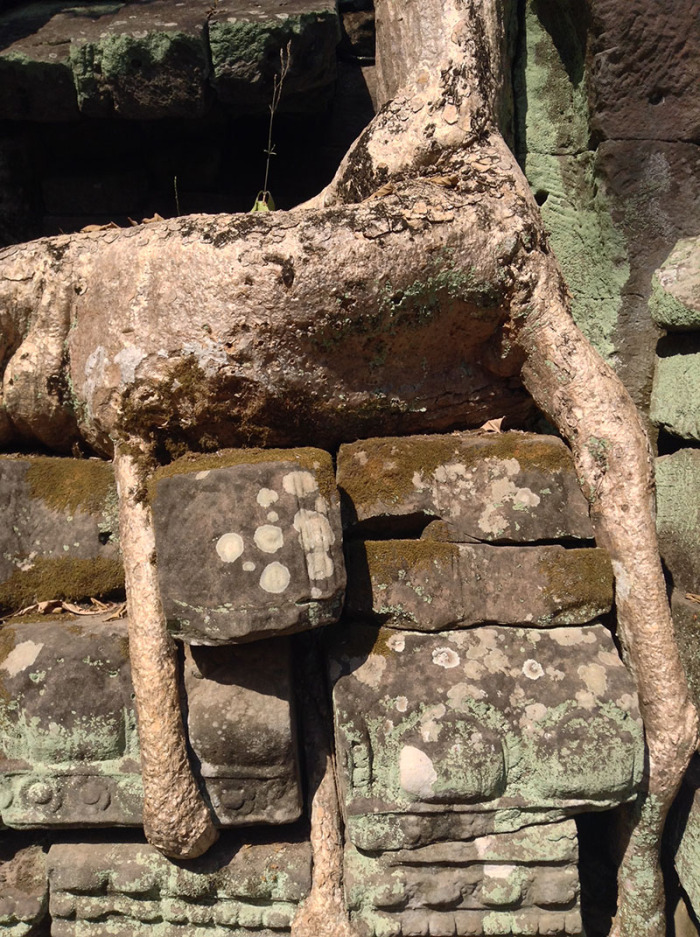
It really feels like the trees—and time itself—is winning her. Whatever the case, there is a lot of renovation being done to the temple, but I know they won’t be removing the trees. They are what give this place its enchanted ambience.
We eventually found a courtyard where the trees were not so prevalent and had fun taking some photos and getting a closer look at some of the stone reliefs.
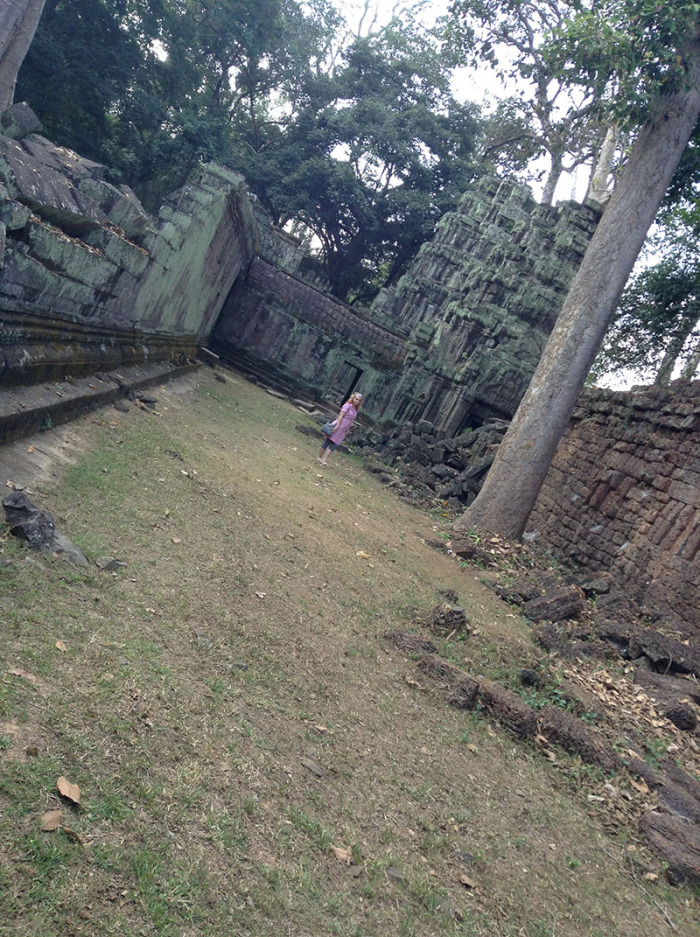
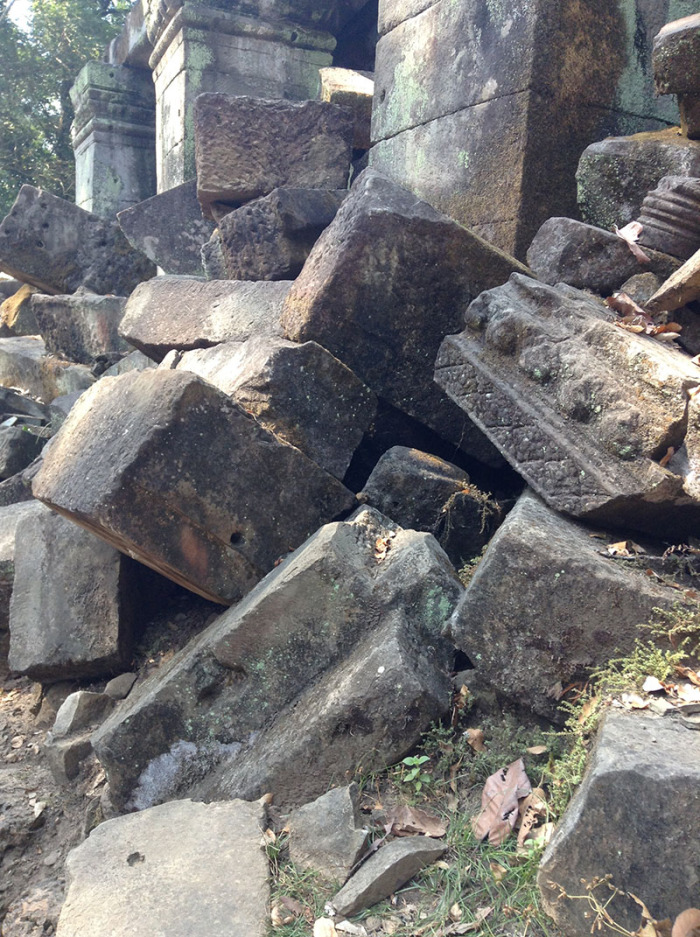
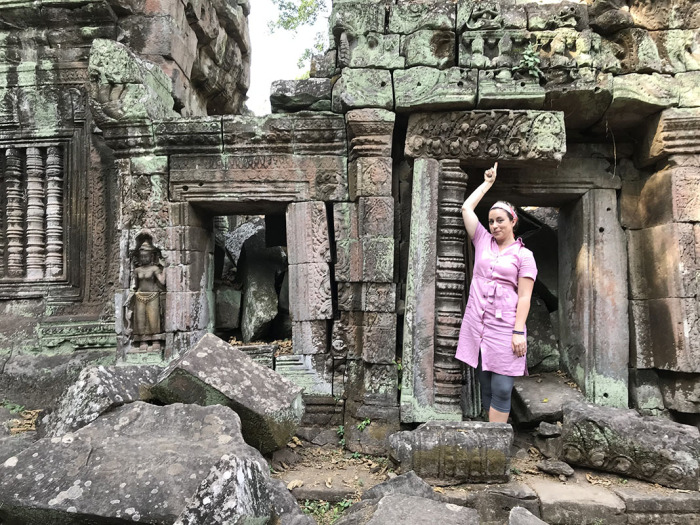
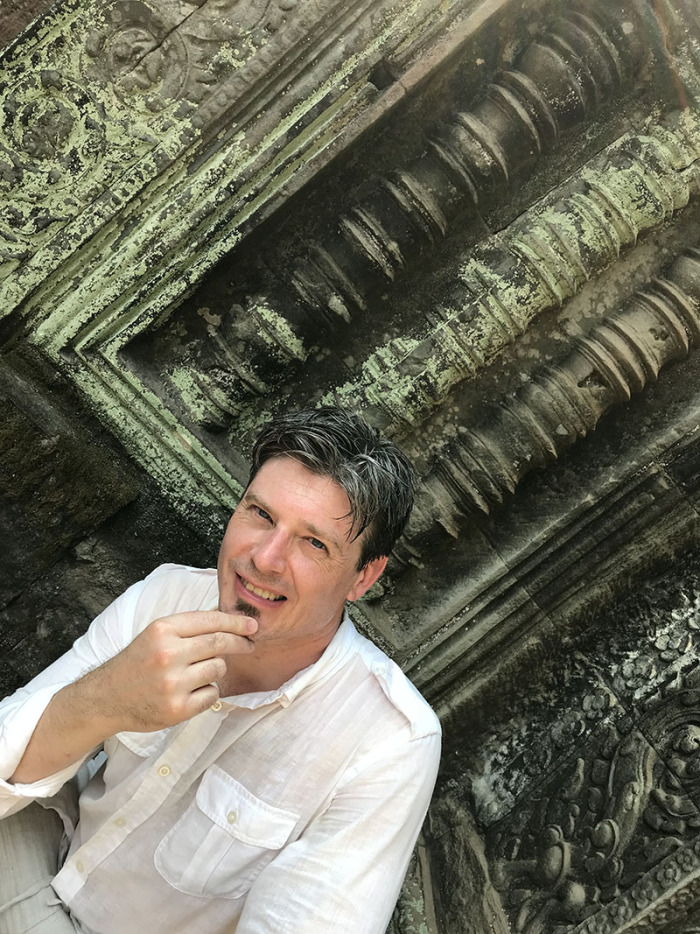
Yam wanted us to visit one more temple before ending our day, and by this point, we knew enough to trust him. So we let his whisk us off to Banteay Kdei, “Citadel of Monk Cells.”
Apparently, this is the temple where they filmed Tomb Raider. We were on our last legs at this point, but knowing this was our last stop of the day, we could enjoy exploring the grounds, snapping photos, and admiring the views and details.
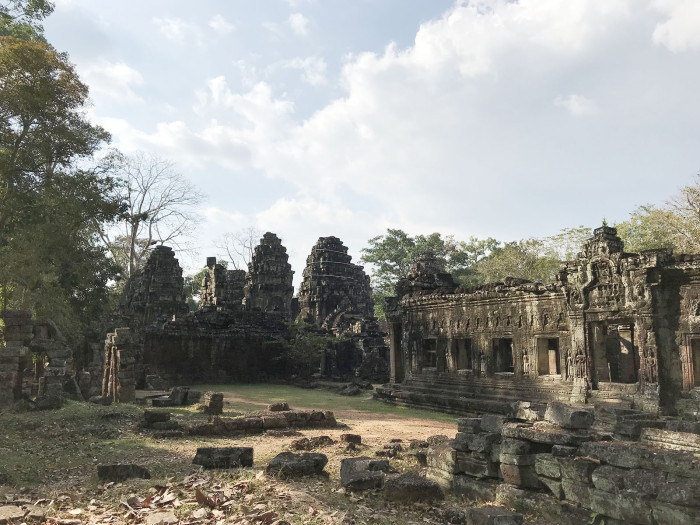
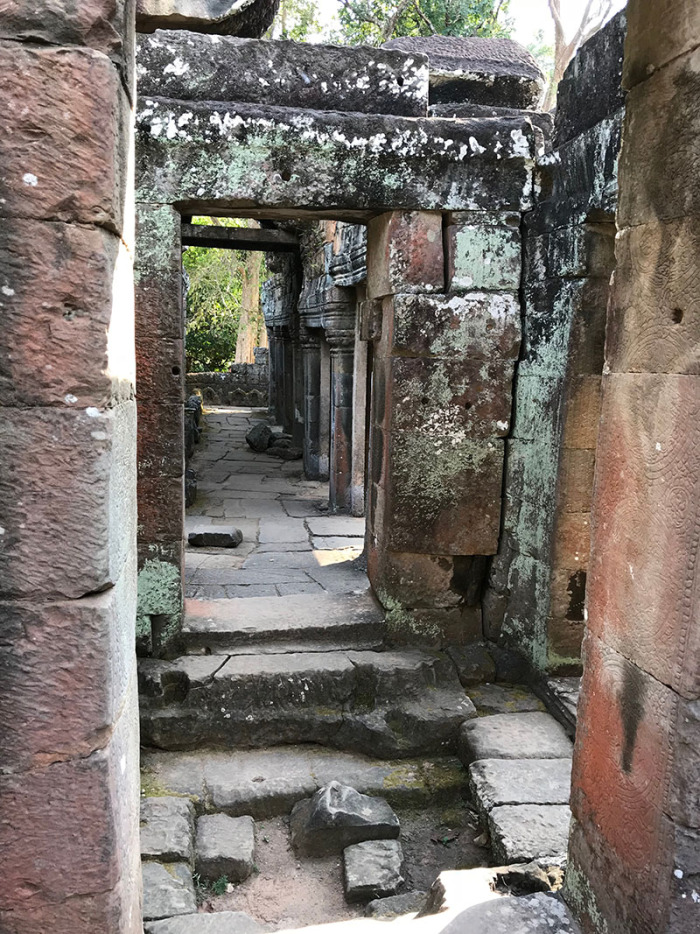
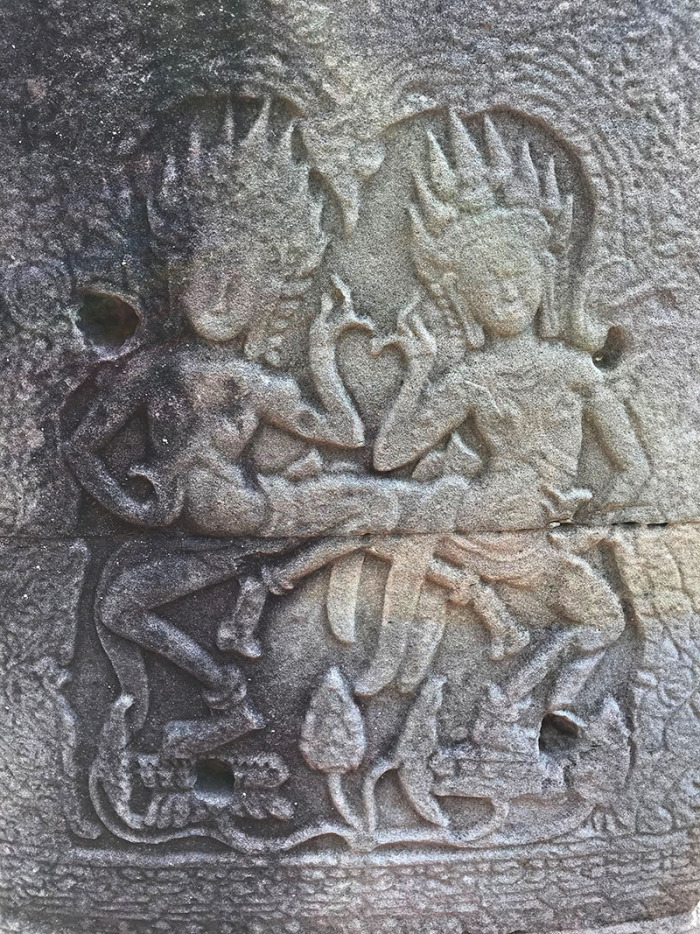
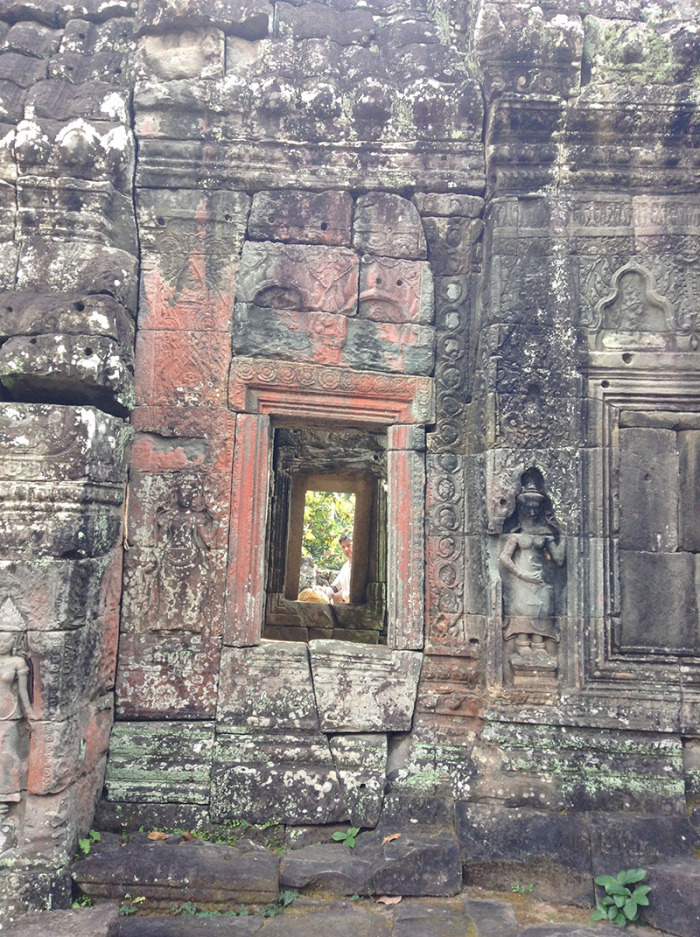
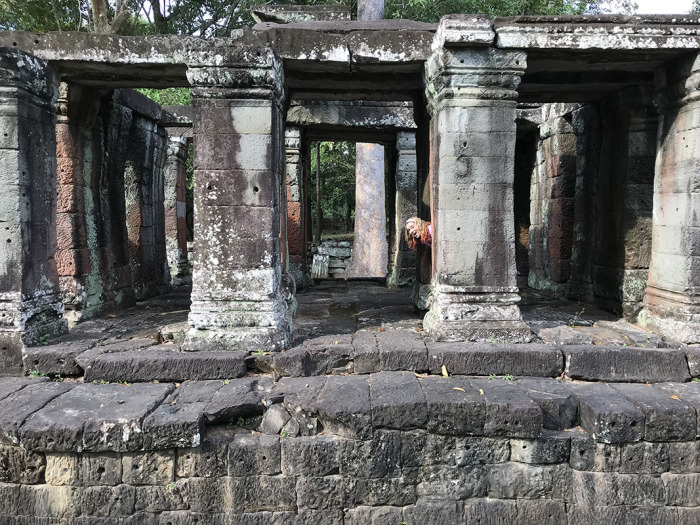
By the time we made it back to our hotel, it was nearing 4:00 pm—so, it had been nearly a twelve-hour day with 24,000 steps (as recorded by Marcie’s iPhone), six bottles of water each, and many litres of sweat given to the earth.
We have a second day of temple touring planned, but for now will take a day off to relax, shop, and recreate in the tourist quarter of Siem Reap.
Advertisements Share this:



